Professional Project: Corporate Governance in Australian Companies
VerifiedAdded on 2020/03/28
|21
|4694
|37
Project
AI Summary
This project, submitted by Jasmeen Kaur, examines the impact of corporate governance on the financial performance of listed Australian companies. The research explores the relationship between corporate governance policies and accounting processes within a sample of ten Australian listed companies. The study investigates whether effective corporate governance leads to positive financial outcomes. The project includes a literature review, outlines the research methodology (including positivism philosophy and a deductive approach), and presents data findings and analysis, leading to conclusions and recommendations. The research aims to identify the impact of corporate governance on accounting processes and determine if effective policies correlate with positive company performance, addressing the core research questions and hypotheses presented in the introduction.

Jasmeen
Kaur, s0274358
BUSN20019 Professional Project
Impact of corporate governance on the performance of listed Australian
companies
SUBMITTED BY:
NAME: Jasmeen Kaur
STUDENT ID: S0274358
1
Kaur, s0274358
BUSN20019 Professional Project
Impact of corporate governance on the performance of listed Australian
companies
SUBMITTED BY:
NAME: Jasmeen Kaur
STUDENT ID: S0274358
1
Paraphrase This Document
Need a fresh take? Get an instant paraphrase of this document with our AI Paraphraser
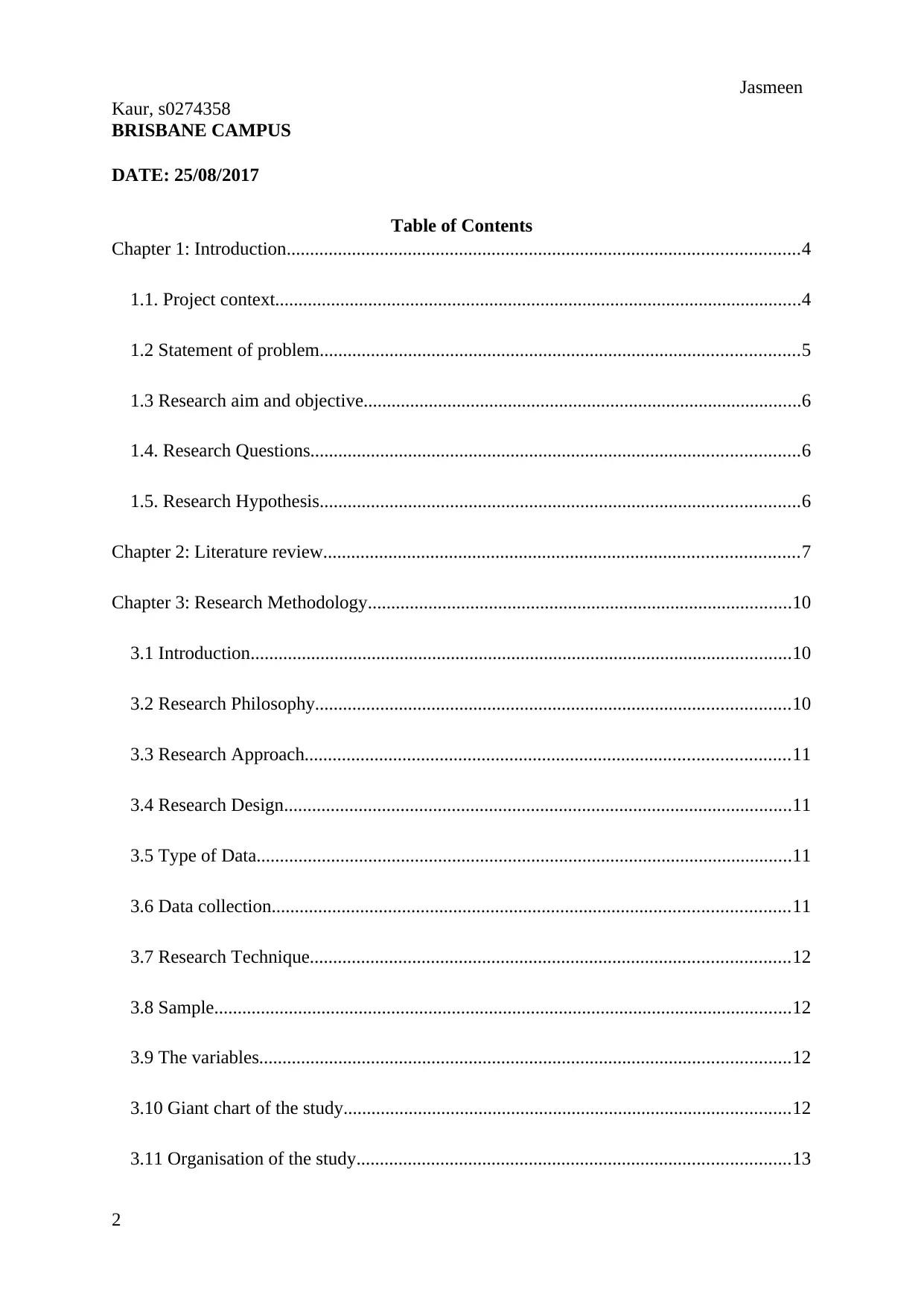
Jasmeen
Kaur, s0274358
BRISBANE CAMPUS
DATE: 25/08/2017
Table of Contents
Chapter 1: Introduction..............................................................................................................4
1.1. Project context.................................................................................................................4
1.2 Statement of problem.......................................................................................................5
1.3 Research aim and objective..............................................................................................6
1.4. Research Questions.........................................................................................................6
1.5. Research Hypothesis.......................................................................................................6
Chapter 2: Literature review......................................................................................................7
Chapter 3: Research Methodology...........................................................................................10
3.1 Introduction....................................................................................................................10
3.2 Research Philosophy......................................................................................................10
3.3 Research Approach........................................................................................................11
3.4 Research Design.............................................................................................................11
3.5 Type of Data...................................................................................................................11
3.6 Data collection...............................................................................................................11
3.7 Research Technique.......................................................................................................12
3.8 Sample............................................................................................................................12
3.9 The variables..................................................................................................................12
3.10 Giant chart of the study................................................................................................12
3.11 Organisation of the study.............................................................................................13
2
Kaur, s0274358
BRISBANE CAMPUS
DATE: 25/08/2017
Table of Contents
Chapter 1: Introduction..............................................................................................................4
1.1. Project context.................................................................................................................4
1.2 Statement of problem.......................................................................................................5
1.3 Research aim and objective..............................................................................................6
1.4. Research Questions.........................................................................................................6
1.5. Research Hypothesis.......................................................................................................6
Chapter 2: Literature review......................................................................................................7
Chapter 3: Research Methodology...........................................................................................10
3.1 Introduction....................................................................................................................10
3.2 Research Philosophy......................................................................................................10
3.3 Research Approach........................................................................................................11
3.4 Research Design.............................................................................................................11
3.5 Type of Data...................................................................................................................11
3.6 Data collection...............................................................................................................11
3.7 Research Technique.......................................................................................................12
3.8 Sample............................................................................................................................12
3.9 The variables..................................................................................................................12
3.10 Giant chart of the study................................................................................................12
3.11 Organisation of the study.............................................................................................13
2
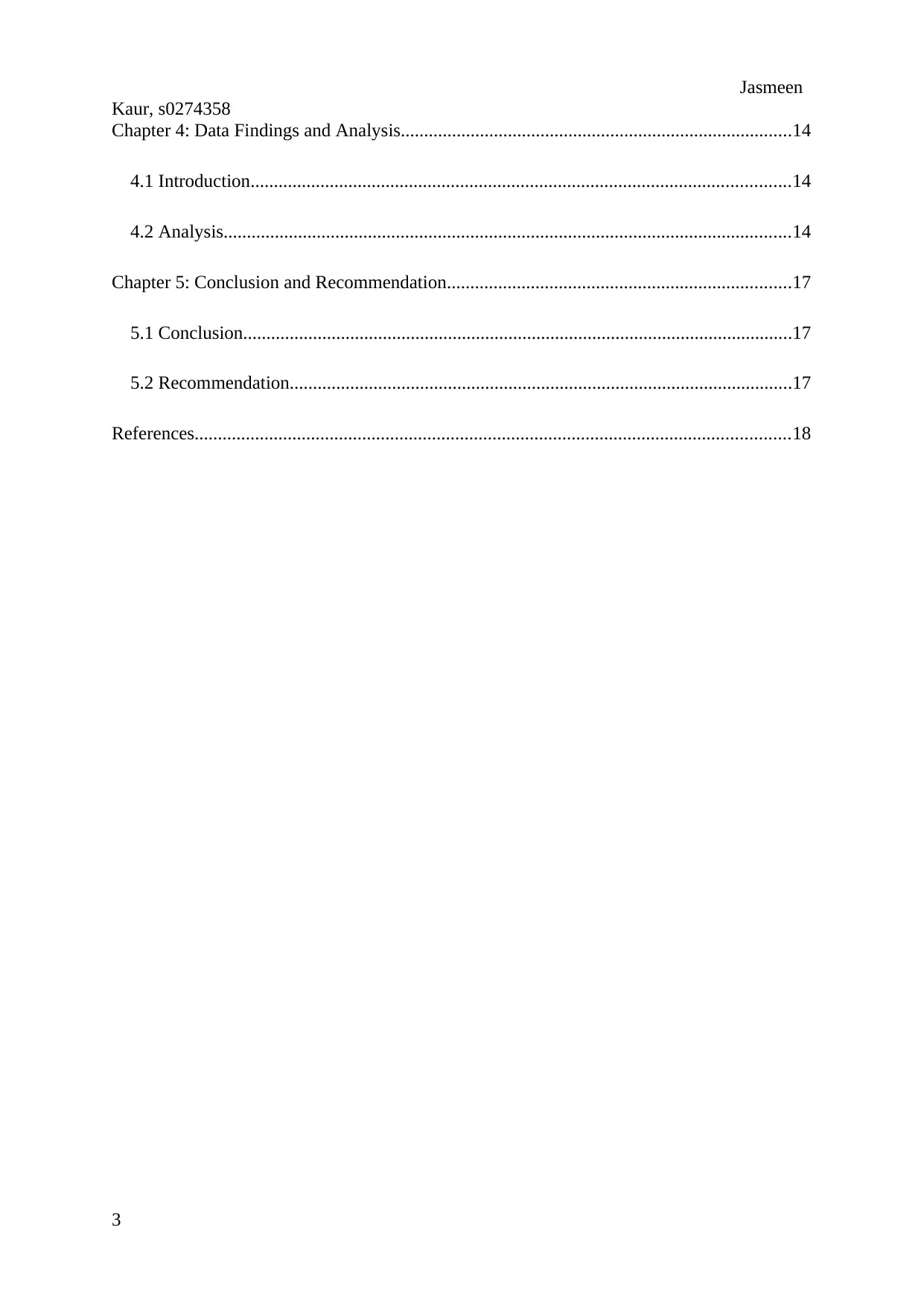
Jasmeen
Kaur, s0274358
Chapter 4: Data Findings and Analysis....................................................................................14
4.1 Introduction....................................................................................................................14
4.2 Analysis..........................................................................................................................14
Chapter 5: Conclusion and Recommendation..........................................................................17
5.1 Conclusion......................................................................................................................17
5.2 Recommendation............................................................................................................17
References................................................................................................................................18
3
Kaur, s0274358
Chapter 4: Data Findings and Analysis....................................................................................14
4.1 Introduction....................................................................................................................14
4.2 Analysis..........................................................................................................................14
Chapter 5: Conclusion and Recommendation..........................................................................17
5.1 Conclusion......................................................................................................................17
5.2 Recommendation............................................................................................................17
References................................................................................................................................18
3
You're viewing a preview
Unlock full access by subscribing today!
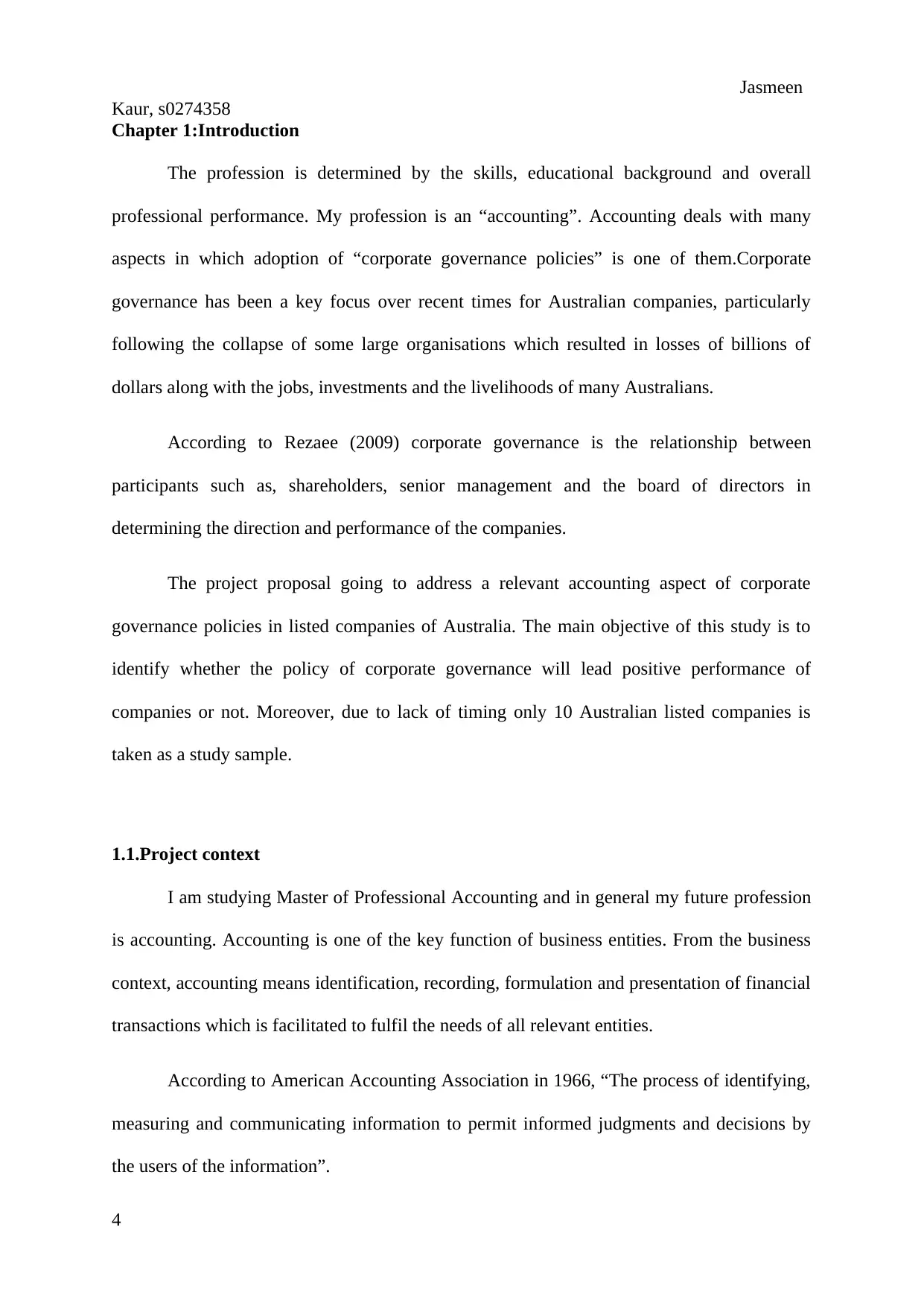
Jasmeen
Kaur, s0274358
Chapter 1:Introduction
The profession is determined by the skills, educational background and overall
professional performance. My profession is an “accounting”. Accounting deals with many
aspects in which adoption of “corporate governance policies” is one of them.Corporate
governance has been a key focus over recent times for Australian companies, particularly
following the collapse of some large organisations which resulted in losses of billions of
dollars along with the jobs, investments and the livelihoods of many Australians.
According to Rezaee (2009) corporate governance is the relationship between
participants such as, shareholders, senior management and the board of directors in
determining the direction and performance of the companies.
The project proposal going to address a relevant accounting aspect of corporate
governance policies in listed companies of Australia. The main objective of this study is to
identify whether the policy of corporate governance will lead positive performance of
companies or not. Moreover, due to lack of timing only 10 Australian listed companies is
taken as a study sample.
1.1.Project context
I am studying Master of Professional Accounting and in general my future profession
is accounting. Accounting is one of the key function of business entities. From the business
context, accounting means identification, recording, formulation and presentation of financial
transactions which is facilitated to fulfil the needs of all relevant entities.
According to American Accounting Association in 1966, “The process of identifying,
measuring and communicating information to permit informed judgments and decisions by
the users of the information”.
4
Kaur, s0274358
Chapter 1:Introduction
The profession is determined by the skills, educational background and overall
professional performance. My profession is an “accounting”. Accounting deals with many
aspects in which adoption of “corporate governance policies” is one of them.Corporate
governance has been a key focus over recent times for Australian companies, particularly
following the collapse of some large organisations which resulted in losses of billions of
dollars along with the jobs, investments and the livelihoods of many Australians.
According to Rezaee (2009) corporate governance is the relationship between
participants such as, shareholders, senior management and the board of directors in
determining the direction and performance of the companies.
The project proposal going to address a relevant accounting aspect of corporate
governance policies in listed companies of Australia. The main objective of this study is to
identify whether the policy of corporate governance will lead positive performance of
companies or not. Moreover, due to lack of timing only 10 Australian listed companies is
taken as a study sample.
1.1.Project context
I am studying Master of Professional Accounting and in general my future profession
is accounting. Accounting is one of the key function of business entities. From the business
context, accounting means identification, recording, formulation and presentation of financial
transactions which is facilitated to fulfil the needs of all relevant entities.
According to American Accounting Association in 1966, “The process of identifying,
measuring and communicating information to permit informed judgments and decisions by
the users of the information”.
4
Paraphrase This Document
Need a fresh take? Get an instant paraphrase of this document with our AI Paraphraser
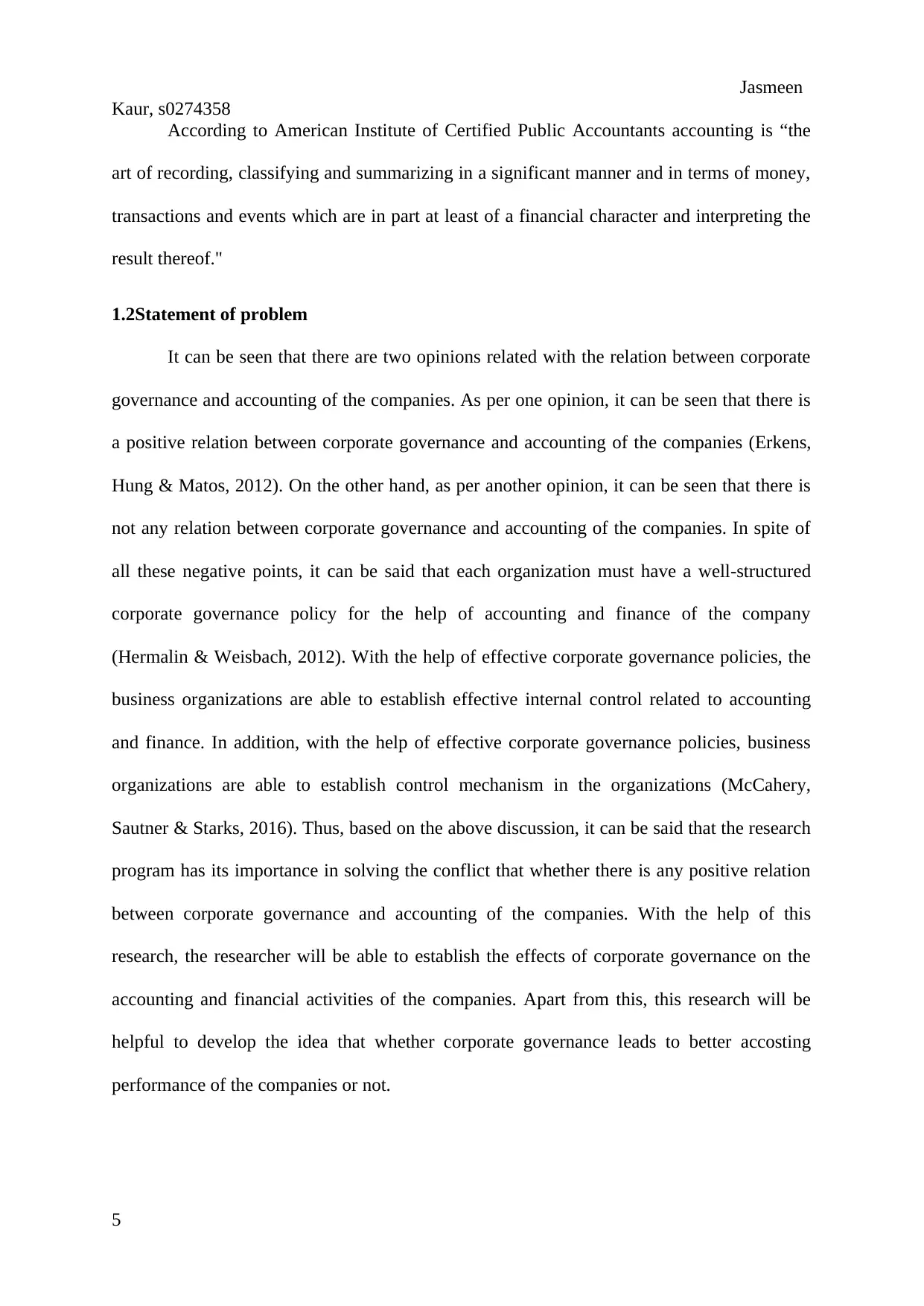
Jasmeen
Kaur, s0274358
According to American Institute of Certified Public Accountants accounting is “the
art of recording, classifying and summarizing in a significant manner and in terms of money,
transactions and events which are in part at least of a financial character and interpreting the
result thereof."
1.2Statement of problem
It can be seen that there are two opinions related with the relation between corporate
governance and accounting of the companies. As per one opinion, it can be seen that there is
a positive relation between corporate governance and accounting of the companies (Erkens,
Hung & Matos, 2012). On the other hand, as per another opinion, it can be seen that there is
not any relation between corporate governance and accounting of the companies. In spite of
all these negative points, it can be said that each organization must have a well-structured
corporate governance policy for the help of accounting and finance of the company
(Hermalin & Weisbach, 2012). With the help of effective corporate governance policies, the
business organizations are able to establish effective internal control related to accounting
and finance. In addition, with the help of effective corporate governance policies, business
organizations are able to establish control mechanism in the organizations (McCahery,
Sautner & Starks, 2016). Thus, based on the above discussion, it can be said that the research
program has its importance in solving the conflict that whether there is any positive relation
between corporate governance and accounting of the companies. With the help of this
research, the researcher will be able to establish the effects of corporate governance on the
accounting and financial activities of the companies. Apart from this, this research will be
helpful to develop the idea that whether corporate governance leads to better accosting
performance of the companies or not.
5
Kaur, s0274358
According to American Institute of Certified Public Accountants accounting is “the
art of recording, classifying and summarizing in a significant manner and in terms of money,
transactions and events which are in part at least of a financial character and interpreting the
result thereof."
1.2Statement of problem
It can be seen that there are two opinions related with the relation between corporate
governance and accounting of the companies. As per one opinion, it can be seen that there is
a positive relation between corporate governance and accounting of the companies (Erkens,
Hung & Matos, 2012). On the other hand, as per another opinion, it can be seen that there is
not any relation between corporate governance and accounting of the companies. In spite of
all these negative points, it can be said that each organization must have a well-structured
corporate governance policy for the help of accounting and finance of the company
(Hermalin & Weisbach, 2012). With the help of effective corporate governance policies, the
business organizations are able to establish effective internal control related to accounting
and finance. In addition, with the help of effective corporate governance policies, business
organizations are able to establish control mechanism in the organizations (McCahery,
Sautner & Starks, 2016). Thus, based on the above discussion, it can be said that the research
program has its importance in solving the conflict that whether there is any positive relation
between corporate governance and accounting of the companies. With the help of this
research, the researcher will be able to establish the effects of corporate governance on the
accounting and financial activities of the companies. Apart from this, this research will be
helpful to develop the idea that whether corporate governance leads to better accosting
performance of the companies or not.
5
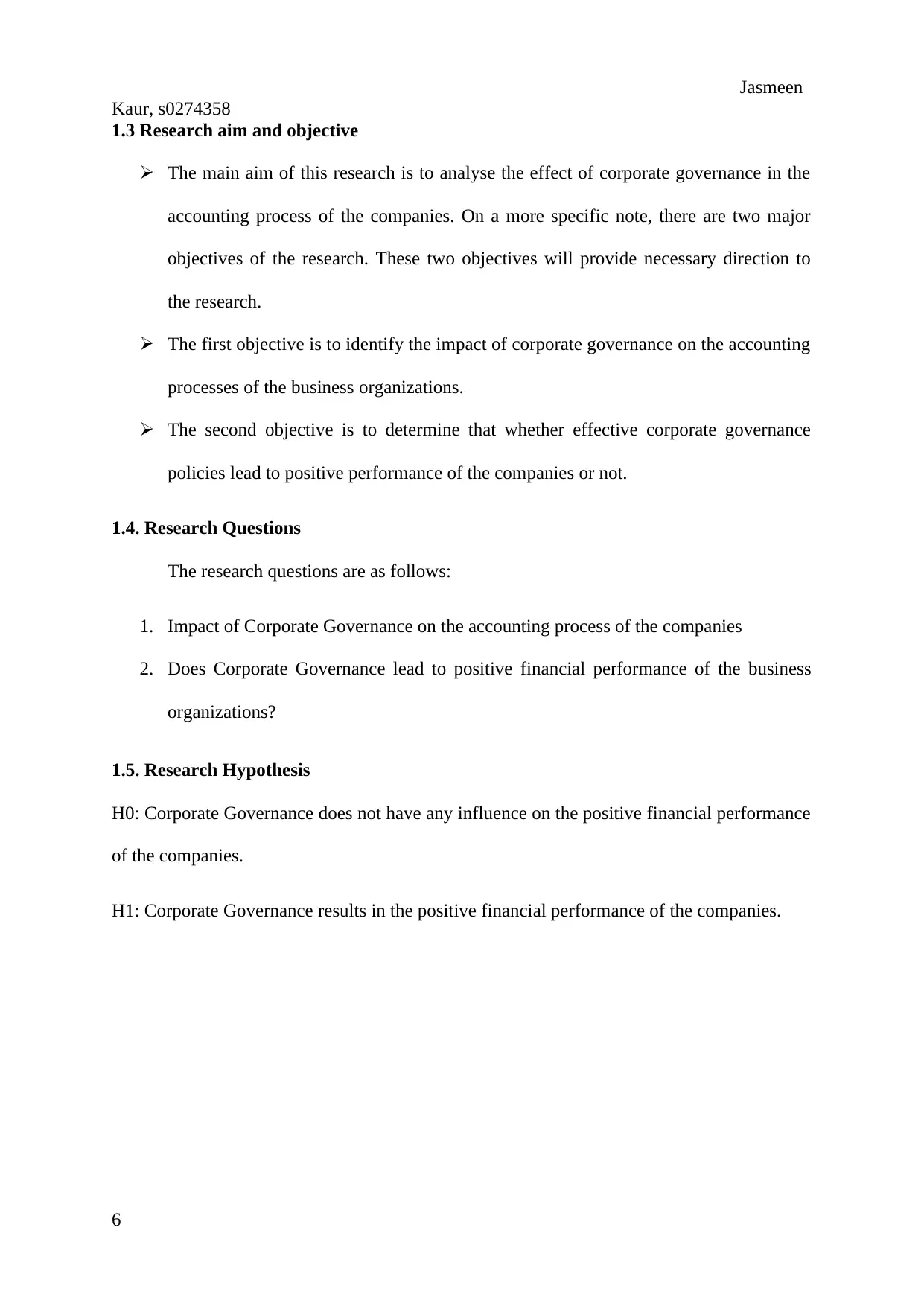
Jasmeen
Kaur, s0274358
1.3 Research aim and objective
The main aim of this research is to analyse the effect of corporate governance in the
accounting process of the companies. On a more specific note, there are two major
objectives of the research. These two objectives will provide necessary direction to
the research.
The first objective is to identify the impact of corporate governance on the accounting
processes of the business organizations.
The second objective is to determine that whether effective corporate governance
policies lead to positive performance of the companies or not.
1.4. Research Questions
The research questions are as follows:
1. Impact of Corporate Governance on the accounting process of the companies
2. Does Corporate Governance lead to positive financial performance of the business
organizations?
1.5. Research Hypothesis
H0: Corporate Governance does not have any influence on the positive financial performance
of the companies.
H1: Corporate Governance results in the positive financial performance of the companies.
6
Kaur, s0274358
1.3 Research aim and objective
The main aim of this research is to analyse the effect of corporate governance in the
accounting process of the companies. On a more specific note, there are two major
objectives of the research. These two objectives will provide necessary direction to
the research.
The first objective is to identify the impact of corporate governance on the accounting
processes of the business organizations.
The second objective is to determine that whether effective corporate governance
policies lead to positive performance of the companies or not.
1.4. Research Questions
The research questions are as follows:
1. Impact of Corporate Governance on the accounting process of the companies
2. Does Corporate Governance lead to positive financial performance of the business
organizations?
1.5. Research Hypothesis
H0: Corporate Governance does not have any influence on the positive financial performance
of the companies.
H1: Corporate Governance results in the positive financial performance of the companies.
6
You're viewing a preview
Unlock full access by subscribing today!
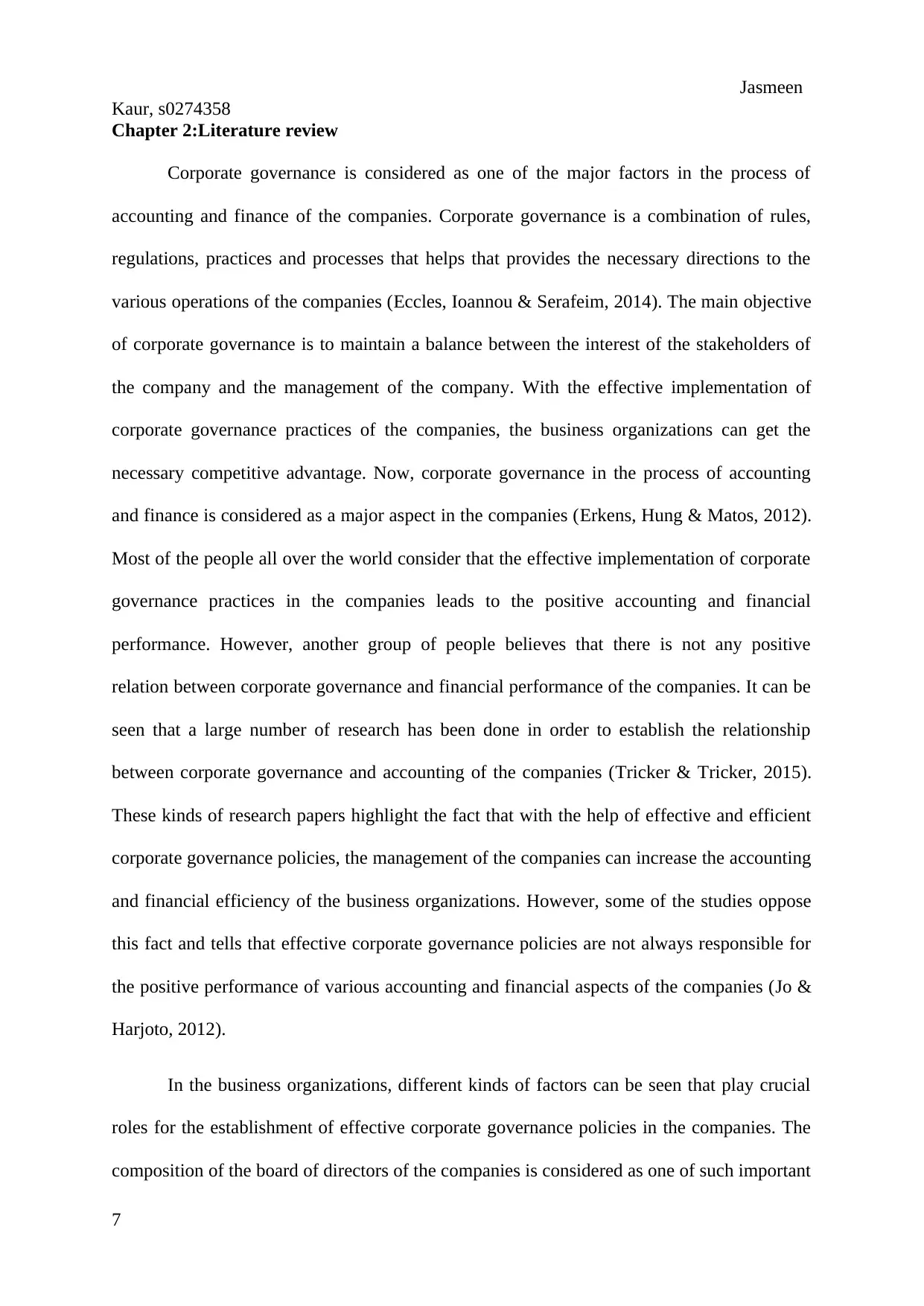
Jasmeen
Kaur, s0274358
Chapter 2:Literature review
Corporate governance is considered as one of the major factors in the process of
accounting and finance of the companies. Corporate governance is a combination of rules,
regulations, practices and processes that helps that provides the necessary directions to the
various operations of the companies (Eccles, Ioannou & Serafeim, 2014). The main objective
of corporate governance is to maintain a balance between the interest of the stakeholders of
the company and the management of the company. With the effective implementation of
corporate governance practices of the companies, the business organizations can get the
necessary competitive advantage. Now, corporate governance in the process of accounting
and finance is considered as a major aspect in the companies (Erkens, Hung & Matos, 2012).
Most of the people all over the world consider that the effective implementation of corporate
governance practices in the companies leads to the positive accounting and financial
performance. However, another group of people believes that there is not any positive
relation between corporate governance and financial performance of the companies. It can be
seen that a large number of research has been done in order to establish the relationship
between corporate governance and accounting of the companies (Tricker & Tricker, 2015).
These kinds of research papers highlight the fact that with the help of effective and efficient
corporate governance policies, the management of the companies can increase the accounting
and financial efficiency of the business organizations. However, some of the studies oppose
this fact and tells that effective corporate governance policies are not always responsible for
the positive performance of various accounting and financial aspects of the companies (Jo &
Harjoto, 2012).
In the business organizations, different kinds of factors can be seen that play crucial
roles for the establishment of effective corporate governance policies in the companies. The
composition of the board of directors of the companies is considered as one of such important
7
Kaur, s0274358
Chapter 2:Literature review
Corporate governance is considered as one of the major factors in the process of
accounting and finance of the companies. Corporate governance is a combination of rules,
regulations, practices and processes that helps that provides the necessary directions to the
various operations of the companies (Eccles, Ioannou & Serafeim, 2014). The main objective
of corporate governance is to maintain a balance between the interest of the stakeholders of
the company and the management of the company. With the effective implementation of
corporate governance practices of the companies, the business organizations can get the
necessary competitive advantage. Now, corporate governance in the process of accounting
and finance is considered as a major aspect in the companies (Erkens, Hung & Matos, 2012).
Most of the people all over the world consider that the effective implementation of corporate
governance practices in the companies leads to the positive accounting and financial
performance. However, another group of people believes that there is not any positive
relation between corporate governance and financial performance of the companies. It can be
seen that a large number of research has been done in order to establish the relationship
between corporate governance and accounting of the companies (Tricker & Tricker, 2015).
These kinds of research papers highlight the fact that with the help of effective and efficient
corporate governance policies, the management of the companies can increase the accounting
and financial efficiency of the business organizations. However, some of the studies oppose
this fact and tells that effective corporate governance policies are not always responsible for
the positive performance of various accounting and financial aspects of the companies (Jo &
Harjoto, 2012).
In the business organizations, different kinds of factors can be seen that play crucial
roles for the establishment of effective corporate governance policies in the companies. The
composition of the board of directors of the companies is considered as one of such important
7
Paraphrase This Document
Need a fresh take? Get an instant paraphrase of this document with our AI Paraphraser
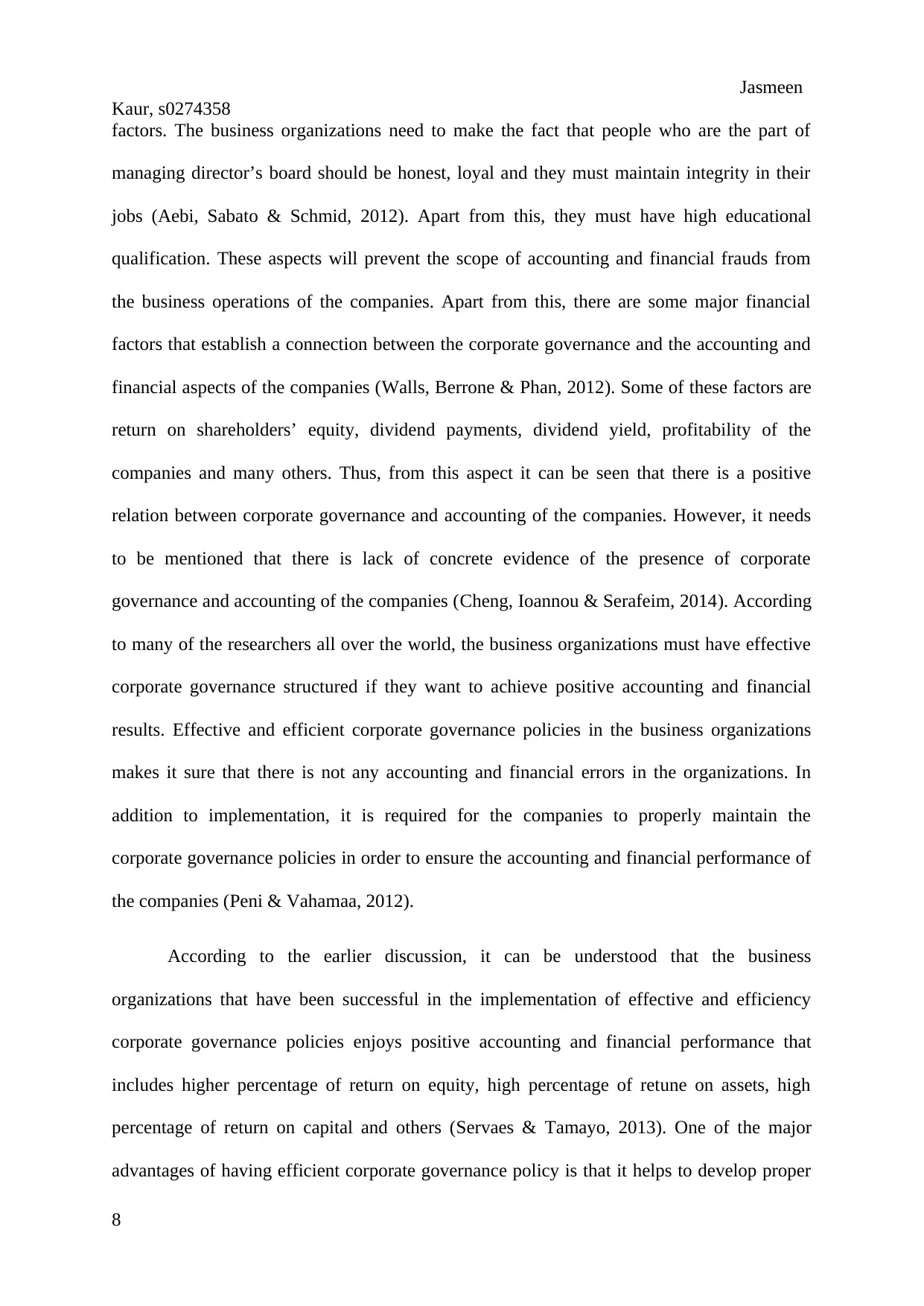
Jasmeen
Kaur, s0274358
factors. The business organizations need to make the fact that people who are the part of
managing director’s board should be honest, loyal and they must maintain integrity in their
jobs (Aebi, Sabato & Schmid, 2012). Apart from this, they must have high educational
qualification. These aspects will prevent the scope of accounting and financial frauds from
the business operations of the companies. Apart from this, there are some major financial
factors that establish a connection between the corporate governance and the accounting and
financial aspects of the companies (Walls, Berrone & Phan, 2012). Some of these factors are
return on shareholders’ equity, dividend payments, dividend yield, profitability of the
companies and many others. Thus, from this aspect it can be seen that there is a positive
relation between corporate governance and accounting of the companies. However, it needs
to be mentioned that there is lack of concrete evidence of the presence of corporate
governance and accounting of the companies (Cheng, Ioannou & Serafeim, 2014). According
to many of the researchers all over the world, the business organizations must have effective
corporate governance structured if they want to achieve positive accounting and financial
results. Effective and efficient corporate governance policies in the business organizations
makes it sure that there is not any accounting and financial errors in the organizations. In
addition to implementation, it is required for the companies to properly maintain the
corporate governance policies in order to ensure the accounting and financial performance of
the companies (Peni & Vahamaa, 2012).
According to the earlier discussion, it can be understood that the business
organizations that have been successful in the implementation of effective and efficiency
corporate governance policies enjoys positive accounting and financial performance that
includes higher percentage of return on equity, high percentage of retune on assets, high
percentage of return on capital and others (Servaes & Tamayo, 2013). One of the major
advantages of having efficient corporate governance policy is that it helps to develop proper
8
Kaur, s0274358
factors. The business organizations need to make the fact that people who are the part of
managing director’s board should be honest, loyal and they must maintain integrity in their
jobs (Aebi, Sabato & Schmid, 2012). Apart from this, they must have high educational
qualification. These aspects will prevent the scope of accounting and financial frauds from
the business operations of the companies. Apart from this, there are some major financial
factors that establish a connection between the corporate governance and the accounting and
financial aspects of the companies (Walls, Berrone & Phan, 2012). Some of these factors are
return on shareholders’ equity, dividend payments, dividend yield, profitability of the
companies and many others. Thus, from this aspect it can be seen that there is a positive
relation between corporate governance and accounting of the companies. However, it needs
to be mentioned that there is lack of concrete evidence of the presence of corporate
governance and accounting of the companies (Cheng, Ioannou & Serafeim, 2014). According
to many of the researchers all over the world, the business organizations must have effective
corporate governance structured if they want to achieve positive accounting and financial
results. Effective and efficient corporate governance policies in the business organizations
makes it sure that there is not any accounting and financial errors in the organizations. In
addition to implementation, it is required for the companies to properly maintain the
corporate governance policies in order to ensure the accounting and financial performance of
the companies (Peni & Vahamaa, 2012).
According to the earlier discussion, it can be understood that the business
organizations that have been successful in the implementation of effective and efficiency
corporate governance policies enjoys positive accounting and financial performance that
includes higher percentage of return on equity, high percentage of retune on assets, high
percentage of return on capital and others (Servaes & Tamayo, 2013). One of the major
advantages of having efficient corporate governance policy is that it helps to develop proper
8
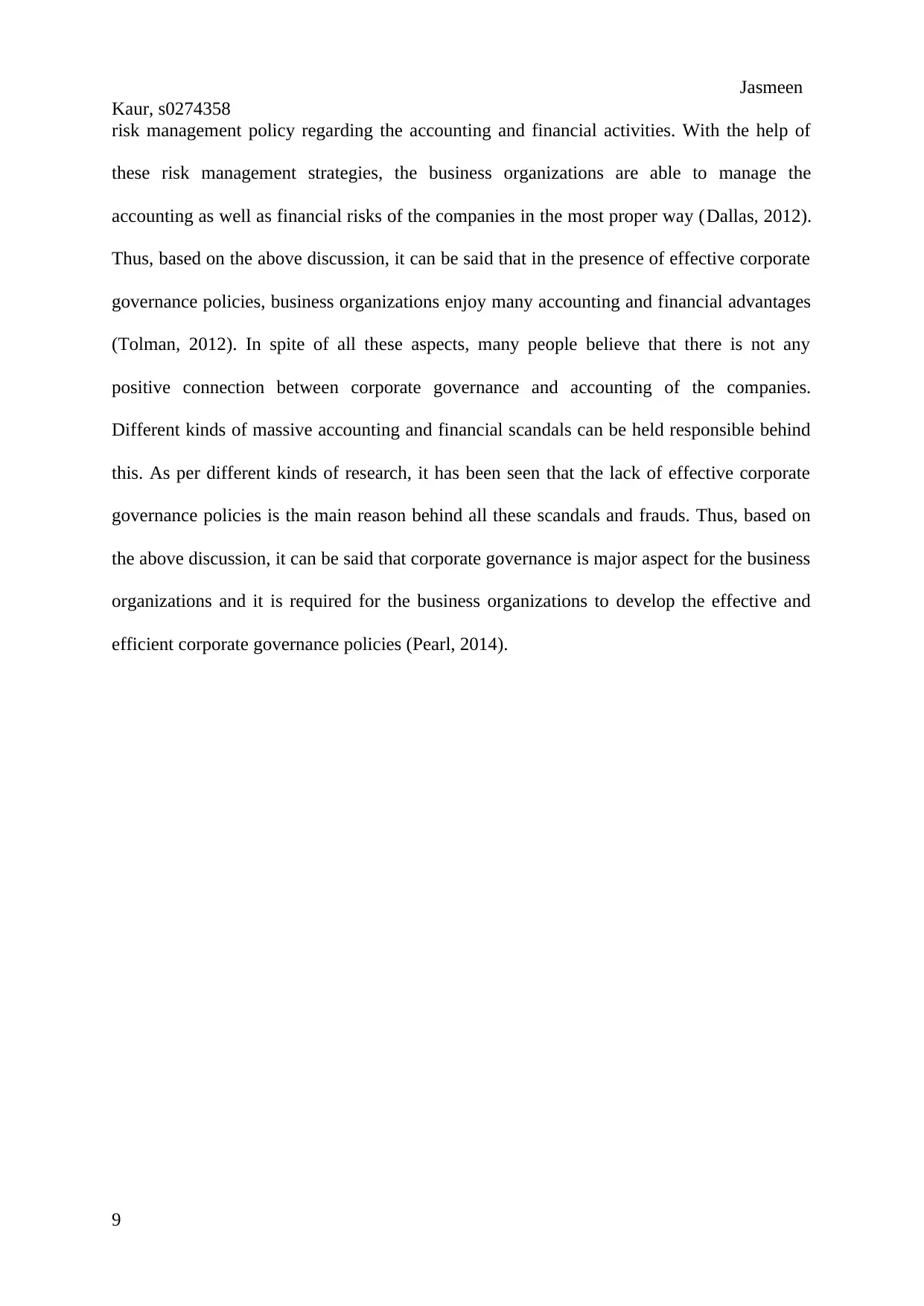
Jasmeen
Kaur, s0274358
risk management policy regarding the accounting and financial activities. With the help of
these risk management strategies, the business organizations are able to manage the
accounting as well as financial risks of the companies in the most proper way (Dallas, 2012).
Thus, based on the above discussion, it can be said that in the presence of effective corporate
governance policies, business organizations enjoy many accounting and financial advantages
(Tolman, 2012). In spite of all these aspects, many people believe that there is not any
positive connection between corporate governance and accounting of the companies.
Different kinds of massive accounting and financial scandals can be held responsible behind
this. As per different kinds of research, it has been seen that the lack of effective corporate
governance policies is the main reason behind all these scandals and frauds. Thus, based on
the above discussion, it can be said that corporate governance is major aspect for the business
organizations and it is required for the business organizations to develop the effective and
efficient corporate governance policies (Pearl, 2014).
9
Kaur, s0274358
risk management policy regarding the accounting and financial activities. With the help of
these risk management strategies, the business organizations are able to manage the
accounting as well as financial risks of the companies in the most proper way (Dallas, 2012).
Thus, based on the above discussion, it can be said that in the presence of effective corporate
governance policies, business organizations enjoy many accounting and financial advantages
(Tolman, 2012). In spite of all these aspects, many people believe that there is not any
positive connection between corporate governance and accounting of the companies.
Different kinds of massive accounting and financial scandals can be held responsible behind
this. As per different kinds of research, it has been seen that the lack of effective corporate
governance policies is the main reason behind all these scandals and frauds. Thus, based on
the above discussion, it can be said that corporate governance is major aspect for the business
organizations and it is required for the business organizations to develop the effective and
efficient corporate governance policies (Pearl, 2014).
9
You're viewing a preview
Unlock full access by subscribing today!
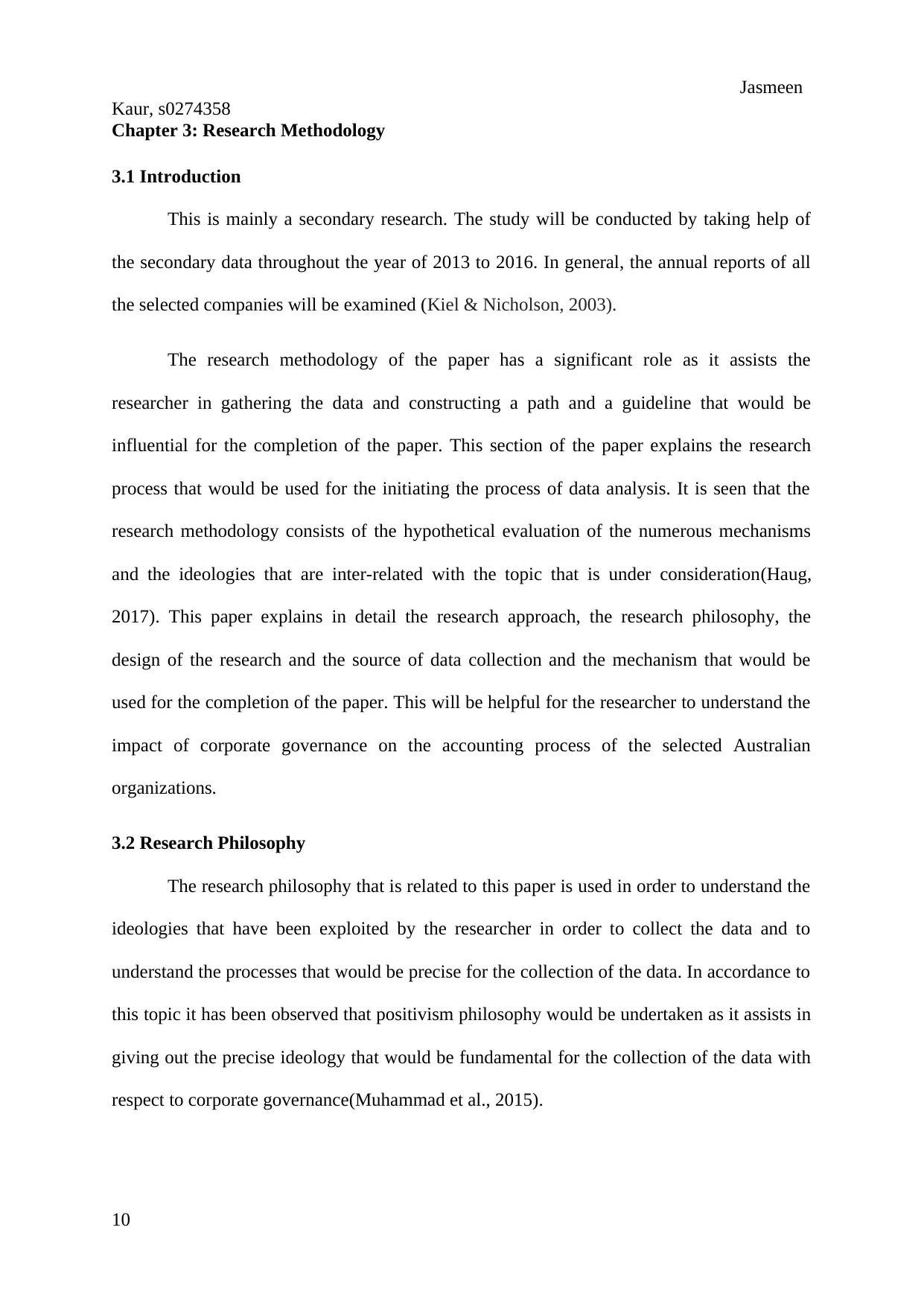
Jasmeen
Kaur, s0274358
Chapter 3: Research Methodology
3.1 Introduction
This is mainly a secondary research. The study will be conducted by taking help of
the secondary data throughout the year of 2013 to 2016. In general, the annual reports of all
the selected companies will be examined (Kiel & Nicholson, 2003).
The research methodology of the paper has a significant role as it assists the
researcher in gathering the data and constructing a path and a guideline that would be
influential for the completion of the paper. This section of the paper explains the research
process that would be used for the initiating the process of data analysis. It is seen that the
research methodology consists of the hypothetical evaluation of the numerous mechanisms
and the ideologies that are inter-related with the topic that is under consideration(Haug,
2017). This paper explains in detail the research approach, the research philosophy, the
design of the research and the source of data collection and the mechanism that would be
used for the completion of the paper. This will be helpful for the researcher to understand the
impact of corporate governance on the accounting process of the selected Australian
organizations.
3.2 Research Philosophy
The research philosophy that is related to this paper is used in order to understand the
ideologies that have been exploited by the researcher in order to collect the data and to
understand the processes that would be precise for the collection of the data. In accordance to
this topic it has been observed that positivism philosophy would be undertaken as it assists in
giving out the precise ideology that would be fundamental for the collection of the data with
respect to corporate governance(Muhammad et al., 2015).
10
Kaur, s0274358
Chapter 3: Research Methodology
3.1 Introduction
This is mainly a secondary research. The study will be conducted by taking help of
the secondary data throughout the year of 2013 to 2016. In general, the annual reports of all
the selected companies will be examined (Kiel & Nicholson, 2003).
The research methodology of the paper has a significant role as it assists the
researcher in gathering the data and constructing a path and a guideline that would be
influential for the completion of the paper. This section of the paper explains the research
process that would be used for the initiating the process of data analysis. It is seen that the
research methodology consists of the hypothetical evaluation of the numerous mechanisms
and the ideologies that are inter-related with the topic that is under consideration(Haug,
2017). This paper explains in detail the research approach, the research philosophy, the
design of the research and the source of data collection and the mechanism that would be
used for the completion of the paper. This will be helpful for the researcher to understand the
impact of corporate governance on the accounting process of the selected Australian
organizations.
3.2 Research Philosophy
The research philosophy that is related to this paper is used in order to understand the
ideologies that have been exploited by the researcher in order to collect the data and to
understand the processes that would be precise for the collection of the data. In accordance to
this topic it has been observed that positivism philosophy would be undertaken as it assists in
giving out the precise ideology that would be fundamental for the collection of the data with
respect to corporate governance(Muhammad et al., 2015).
10
Paraphrase This Document
Need a fresh take? Get an instant paraphrase of this document with our AI Paraphraser
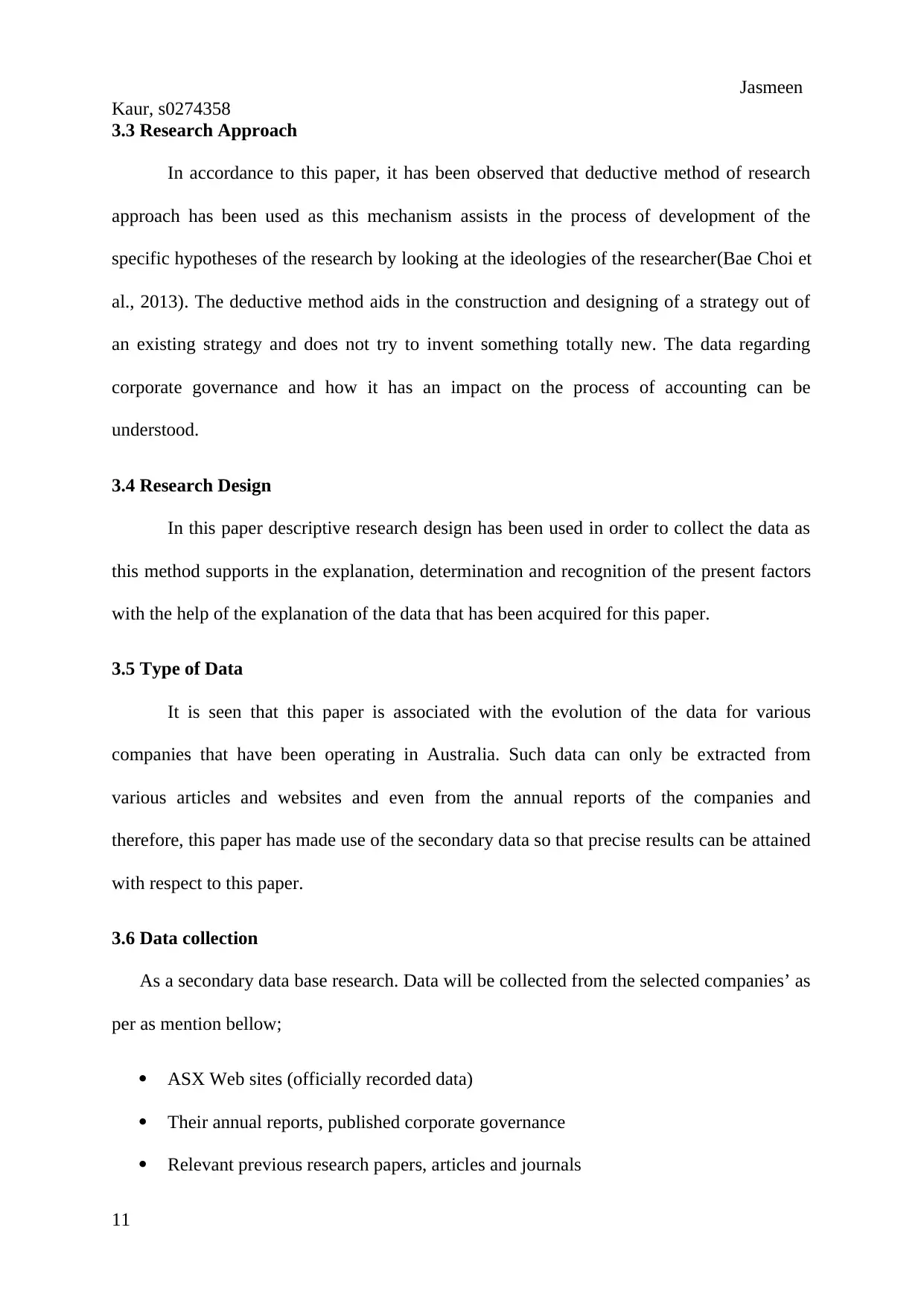
Jasmeen
Kaur, s0274358
3.3 Research Approach
In accordance to this paper, it has been observed that deductive method of research
approach has been used as this mechanism assists in the process of development of the
specific hypotheses of the research by looking at the ideologies of the researcher(Bae Choi et
al., 2013). The deductive method aids in the construction and designing of a strategy out of
an existing strategy and does not try to invent something totally new. The data regarding
corporate governance and how it has an impact on the process of accounting can be
understood.
3.4 Research Design
In this paper descriptive research design has been used in order to collect the data as
this method supports in the explanation, determination and recognition of the present factors
with the help of the explanation of the data that has been acquired for this paper.
3.5 Type of Data
It is seen that this paper is associated with the evolution of the data for various
companies that have been operating in Australia. Such data can only be extracted from
various articles and websites and even from the annual reports of the companies and
therefore, this paper has made use of the secondary data so that precise results can be attained
with respect to this paper.
3.6 Data collection
As a secondary data base research. Data will be collected from the selected companies’ as
per as mention bellow;
ASX Web sites (officially recorded data)
Their annual reports, published corporate governance
Relevant previous research papers, articles and journals
11
Kaur, s0274358
3.3 Research Approach
In accordance to this paper, it has been observed that deductive method of research
approach has been used as this mechanism assists in the process of development of the
specific hypotheses of the research by looking at the ideologies of the researcher(Bae Choi et
al., 2013). The deductive method aids in the construction and designing of a strategy out of
an existing strategy and does not try to invent something totally new. The data regarding
corporate governance and how it has an impact on the process of accounting can be
understood.
3.4 Research Design
In this paper descriptive research design has been used in order to collect the data as
this method supports in the explanation, determination and recognition of the present factors
with the help of the explanation of the data that has been acquired for this paper.
3.5 Type of Data
It is seen that this paper is associated with the evolution of the data for various
companies that have been operating in Australia. Such data can only be extracted from
various articles and websites and even from the annual reports of the companies and
therefore, this paper has made use of the secondary data so that precise results can be attained
with respect to this paper.
3.6 Data collection
As a secondary data base research. Data will be collected from the selected companies’ as
per as mention bellow;
ASX Web sites (officially recorded data)
Their annual reports, published corporate governance
Relevant previous research papers, articles and journals
11
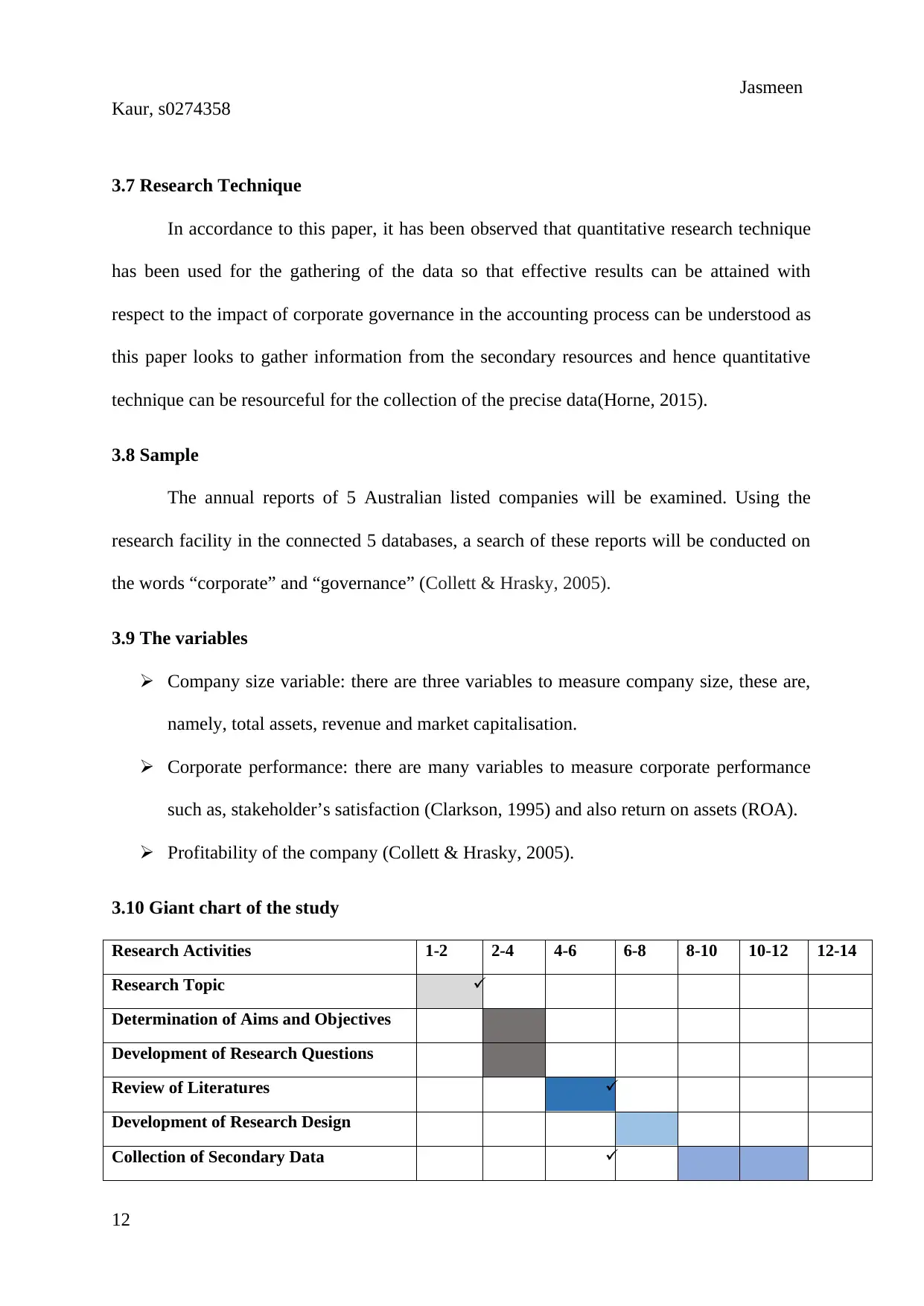
Jasmeen
Kaur, s0274358
3.7 Research Technique
In accordance to this paper, it has been observed that quantitative research technique
has been used for the gathering of the data so that effective results can be attained with
respect to the impact of corporate governance in the accounting process can be understood as
this paper looks to gather information from the secondary resources and hence quantitative
technique can be resourceful for the collection of the precise data(Horne, 2015).
3.8 Sample
The annual reports of 5 Australian listed companies will be examined. Using the
research facility in the connected 5 databases, a search of these reports will be conducted on
the words “corporate” and “governance” (Collett & Hrasky, 2005).
3.9 The variables
Company size variable: there are three variables to measure company size, these are,
namely, total assets, revenue and market capitalisation.
Corporate performance: there are many variables to measure corporate performance
such as, stakeholder’s satisfaction (Clarkson, 1995) and also return on assets (ROA).
Profitability of the company (Collett & Hrasky, 2005).
3.10 Giant chart of the study
Research Activities 1-2 2-4 4-6 6-8 8-10 10-12 12-14
Research Topic
Determination of Aims and Objectives
Development of Research Questions
Review of Literatures
Development of Research Design
Collection of Secondary Data
12
Kaur, s0274358
3.7 Research Technique
In accordance to this paper, it has been observed that quantitative research technique
has been used for the gathering of the data so that effective results can be attained with
respect to the impact of corporate governance in the accounting process can be understood as
this paper looks to gather information from the secondary resources and hence quantitative
technique can be resourceful for the collection of the precise data(Horne, 2015).
3.8 Sample
The annual reports of 5 Australian listed companies will be examined. Using the
research facility in the connected 5 databases, a search of these reports will be conducted on
the words “corporate” and “governance” (Collett & Hrasky, 2005).
3.9 The variables
Company size variable: there are three variables to measure company size, these are,
namely, total assets, revenue and market capitalisation.
Corporate performance: there are many variables to measure corporate performance
such as, stakeholder’s satisfaction (Clarkson, 1995) and also return on assets (ROA).
Profitability of the company (Collett & Hrasky, 2005).
3.10 Giant chart of the study
Research Activities 1-2 2-4 4-6 6-8 8-10 10-12 12-14
Research Topic
Determination of Aims and Objectives
Development of Research Questions
Review of Literatures
Development of Research Design
Collection of Secondary Data
12
You're viewing a preview
Unlock full access by subscribing today!
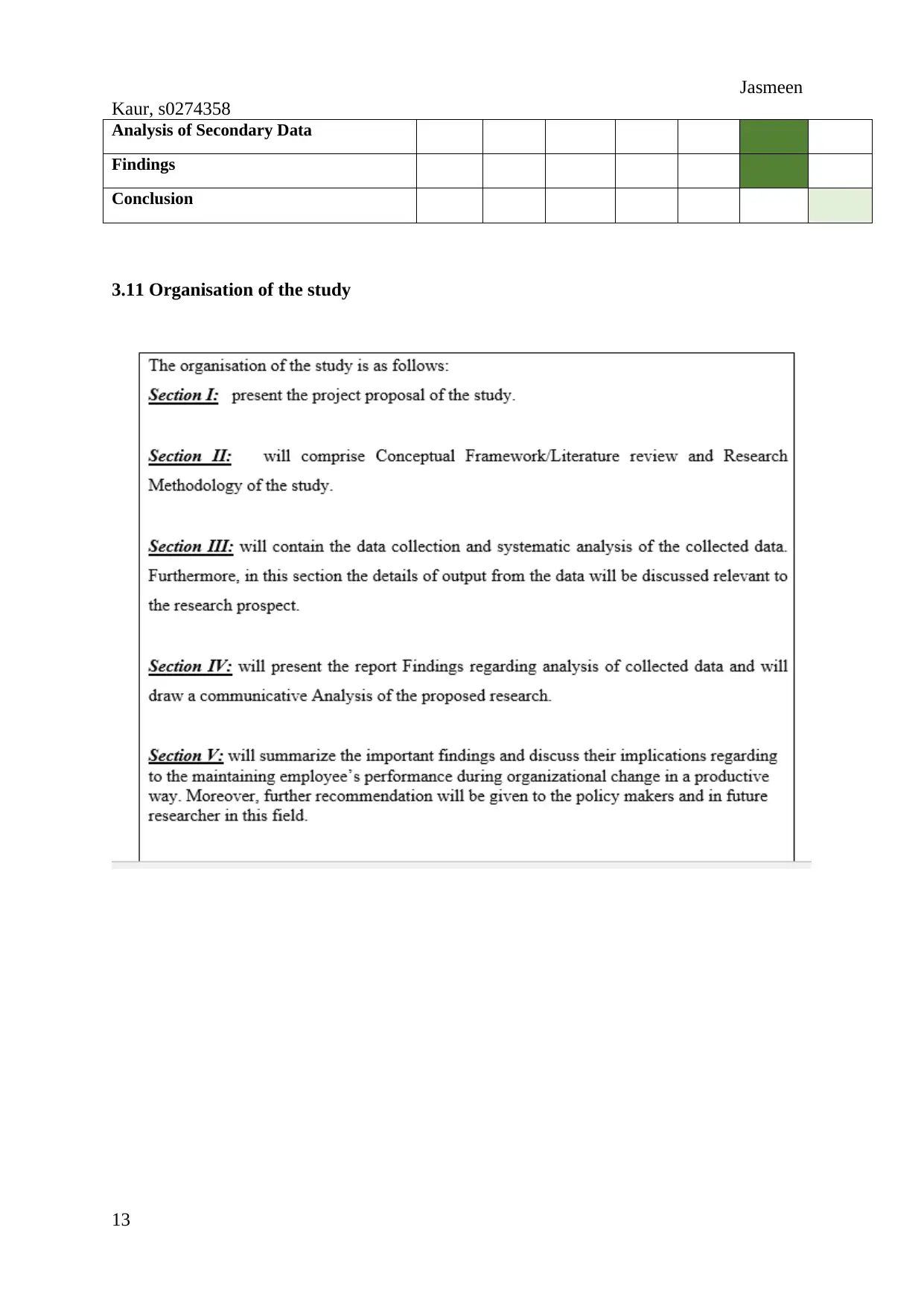
Jasmeen
Kaur, s0274358
Analysis of Secondary Data
Findings
Conclusion
3.11 Organisation of the study
13
Kaur, s0274358
Analysis of Secondary Data
Findings
Conclusion
3.11 Organisation of the study
13
Paraphrase This Document
Need a fresh take? Get an instant paraphrase of this document with our AI Paraphraser
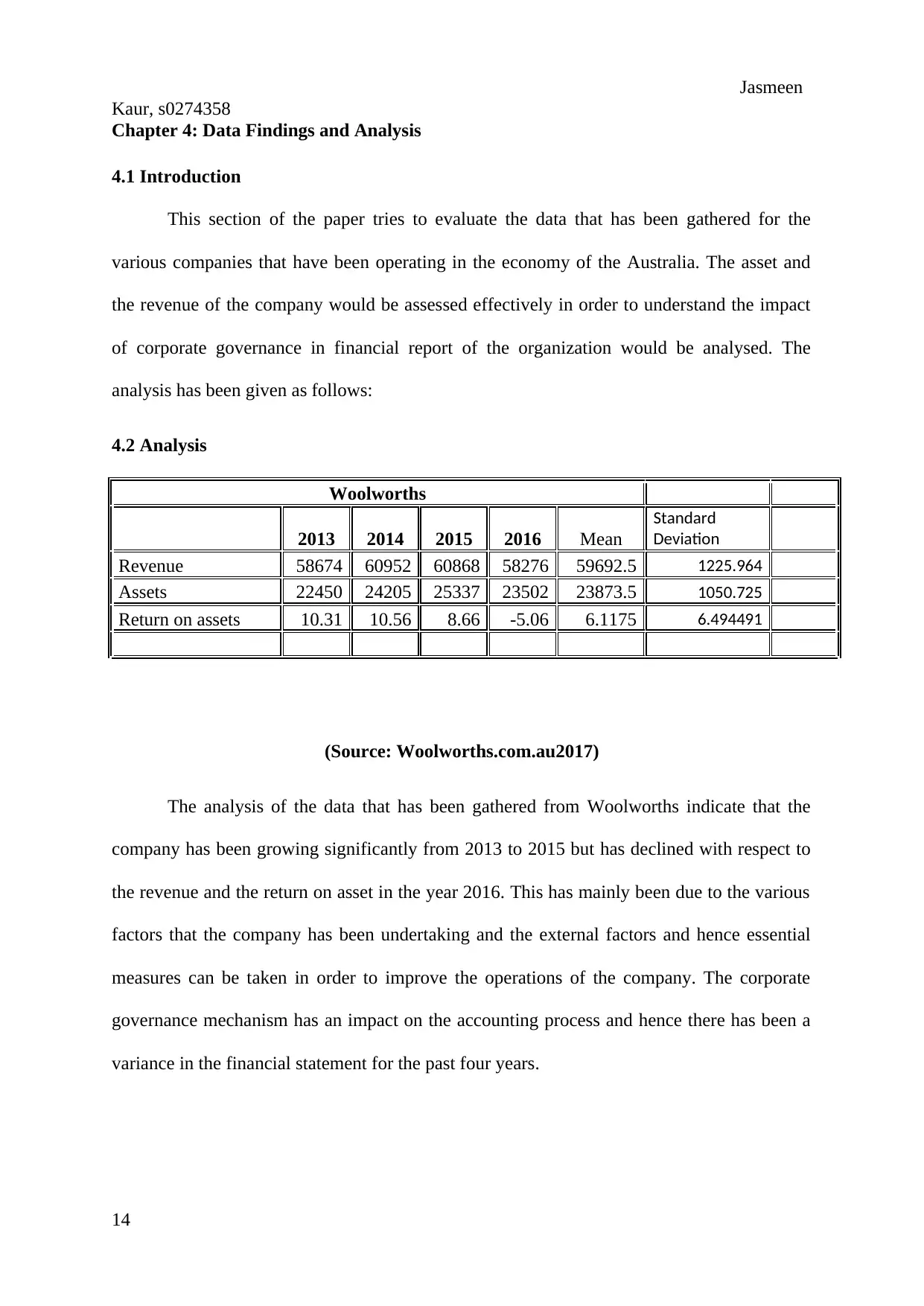
Jasmeen
Kaur, s0274358
Chapter 4: Data Findings and Analysis
4.1 Introduction
This section of the paper tries to evaluate the data that has been gathered for the
various companies that have been operating in the economy of the Australia. The asset and
the revenue of the company would be assessed effectively in order to understand the impact
of corporate governance in financial report of the organization would be analysed. The
analysis has been given as follows:
4.2 Analysis
Woolworths
2013 2014 2015 2016 Mean
Standard
Deviation
Revenue 58674 60952 60868 58276 59692.5 1225.964
Assets 22450 24205 25337 23502 23873.5 1050.725
Return on assets 10.31 10.56 8.66 -5.06 6.1175 6.494491
(Source: Woolworths.com.au2017)
The analysis of the data that has been gathered from Woolworths indicate that the
company has been growing significantly from 2013 to 2015 but has declined with respect to
the revenue and the return on asset in the year 2016. This has mainly been due to the various
factors that the company has been undertaking and the external factors and hence essential
measures can be taken in order to improve the operations of the company. The corporate
governance mechanism has an impact on the accounting process and hence there has been a
variance in the financial statement for the past four years.
14
Kaur, s0274358
Chapter 4: Data Findings and Analysis
4.1 Introduction
This section of the paper tries to evaluate the data that has been gathered for the
various companies that have been operating in the economy of the Australia. The asset and
the revenue of the company would be assessed effectively in order to understand the impact
of corporate governance in financial report of the organization would be analysed. The
analysis has been given as follows:
4.2 Analysis
Woolworths
2013 2014 2015 2016 Mean
Standard
Deviation
Revenue 58674 60952 60868 58276 59692.5 1225.964
Assets 22450 24205 25337 23502 23873.5 1050.725
Return on assets 10.31 10.56 8.66 -5.06 6.1175 6.494491
(Source: Woolworths.com.au2017)
The analysis of the data that has been gathered from Woolworths indicate that the
company has been growing significantly from 2013 to 2015 but has declined with respect to
the revenue and the return on asset in the year 2016. This has mainly been due to the various
factors that the company has been undertaking and the external factors and hence essential
measures can be taken in order to improve the operations of the company. The corporate
governance mechanism has an impact on the accounting process and hence there has been a
variance in the financial statement for the past four years.
14
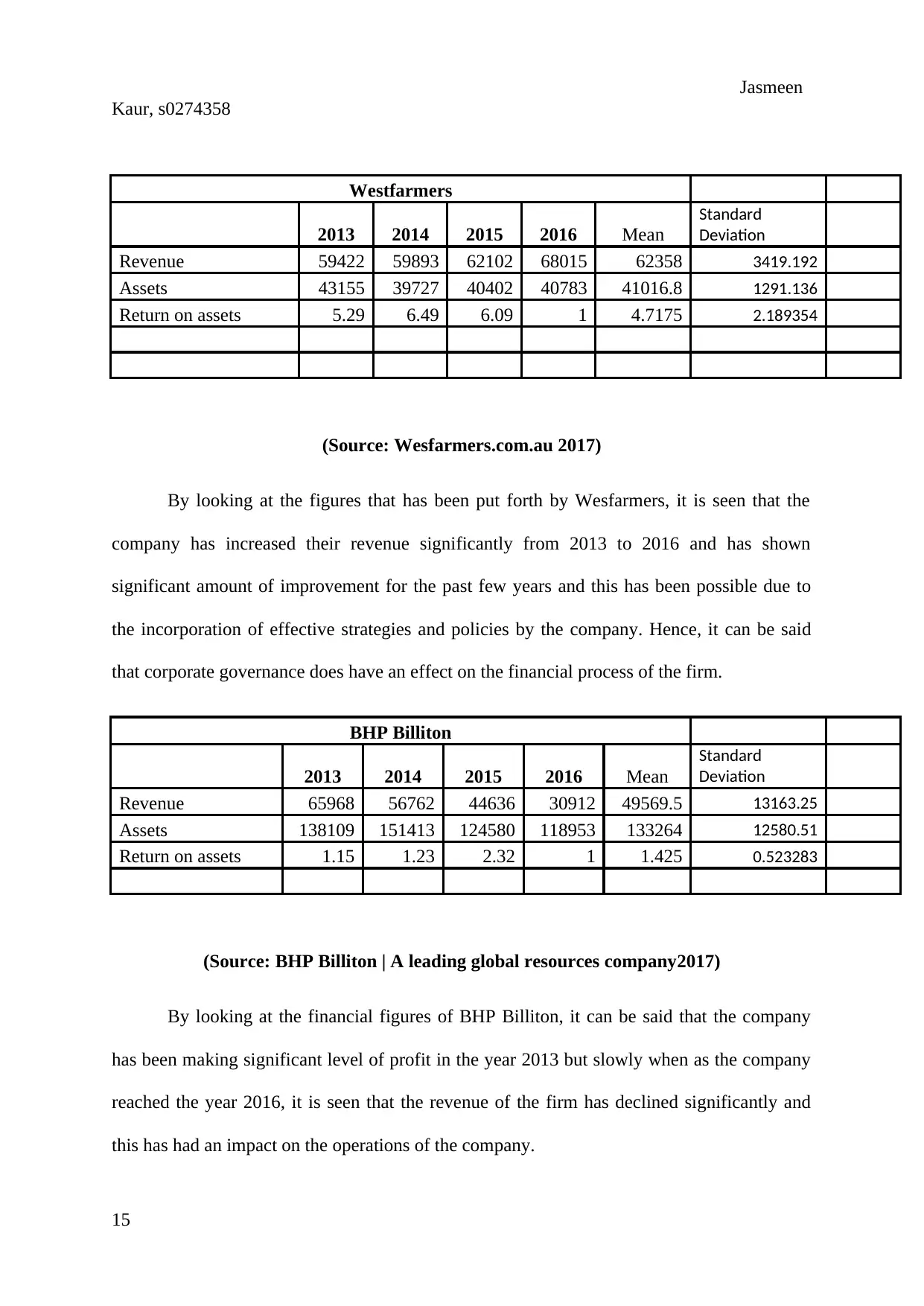
Jasmeen
Kaur, s0274358
Westfarmers
2013 2014 2015 2016 Mean
Standard
Deviation
Revenue 59422 59893 62102 68015 62358 3419.192
Assets 43155 39727 40402 40783 41016.8 1291.136
Return on assets 5.29 6.49 6.09 1 4.7175 2.189354
(Source: Wesfarmers.com.au 2017)
By looking at the figures that has been put forth by Wesfarmers, it is seen that the
company has increased their revenue significantly from 2013 to 2016 and has shown
significant amount of improvement for the past few years and this has been possible due to
the incorporation of effective strategies and policies by the company. Hence, it can be said
that corporate governance does have an effect on the financial process of the firm.
BHP Billiton
2013 2014 2015 2016 Mean
Standard
Deviation
Revenue 65968 56762 44636 30912 49569.5 13163.25
Assets 138109 151413 124580 118953 133264 12580.51
Return on assets 1.15 1.23 2.32 1 1.425 0.523283
(Source: BHP Billiton | A leading global resources company2017)
By looking at the financial figures of BHP Billiton, it can be said that the company
has been making significant level of profit in the year 2013 but slowly when as the company
reached the year 2016, it is seen that the revenue of the firm has declined significantly and
this has had an impact on the operations of the company.
15
Kaur, s0274358
Westfarmers
2013 2014 2015 2016 Mean
Standard
Deviation
Revenue 59422 59893 62102 68015 62358 3419.192
Assets 43155 39727 40402 40783 41016.8 1291.136
Return on assets 5.29 6.49 6.09 1 4.7175 2.189354
(Source: Wesfarmers.com.au 2017)
By looking at the figures that has been put forth by Wesfarmers, it is seen that the
company has increased their revenue significantly from 2013 to 2016 and has shown
significant amount of improvement for the past few years and this has been possible due to
the incorporation of effective strategies and policies by the company. Hence, it can be said
that corporate governance does have an effect on the financial process of the firm.
BHP Billiton
2013 2014 2015 2016 Mean
Standard
Deviation
Revenue 65968 56762 44636 30912 49569.5 13163.25
Assets 138109 151413 124580 118953 133264 12580.51
Return on assets 1.15 1.23 2.32 1 1.425 0.523283
(Source: BHP Billiton | A leading global resources company2017)
By looking at the financial figures of BHP Billiton, it can be said that the company
has been making significant level of profit in the year 2013 but slowly when as the company
reached the year 2016, it is seen that the revenue of the firm has declined significantly and
this has had an impact on the operations of the company.
15
You're viewing a preview
Unlock full access by subscribing today!
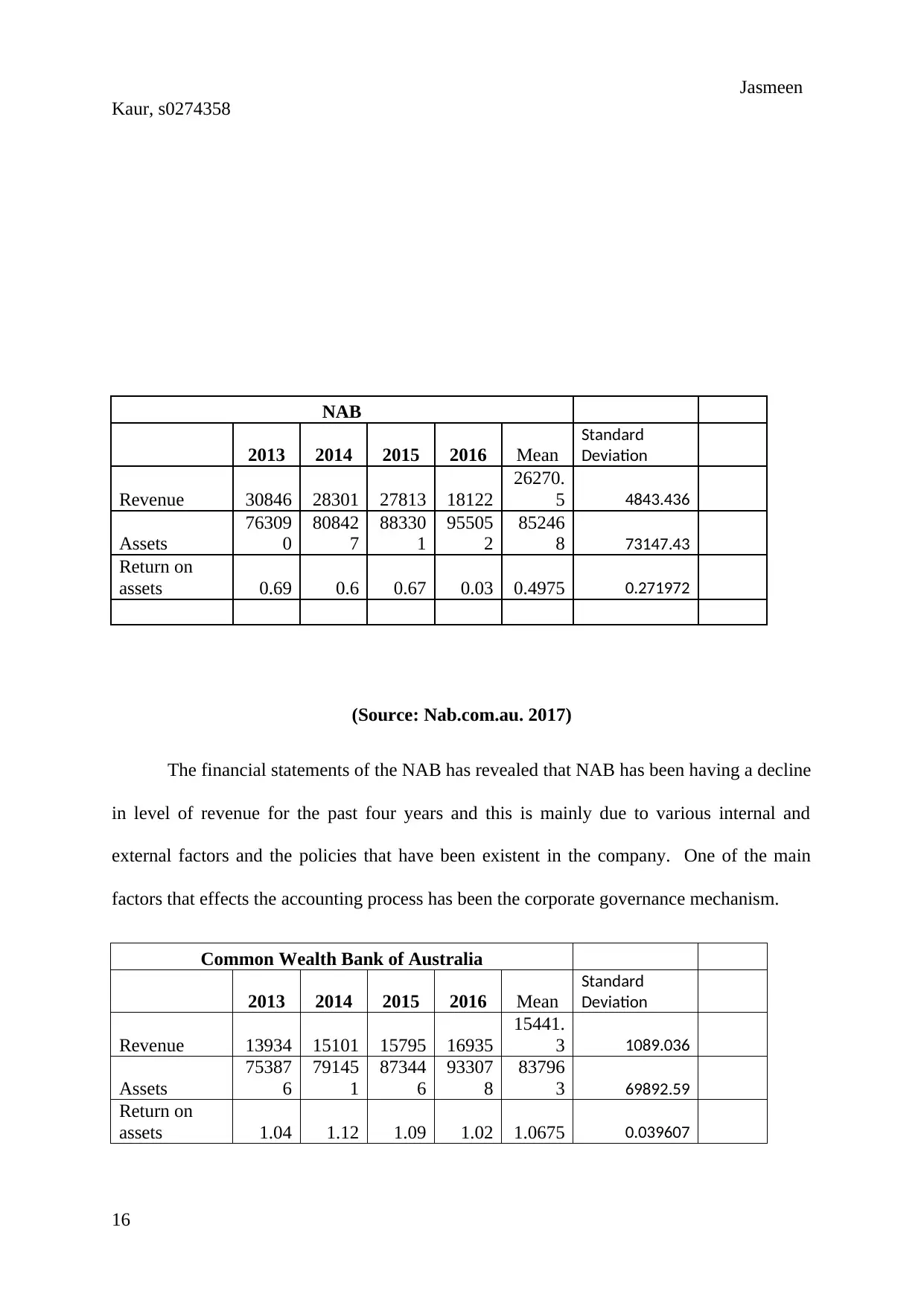
Jasmeen
Kaur, s0274358
NAB
2013 2014 2015 2016 Mean
Standard
Deviation
Revenue 30846 28301 27813 18122
26270.
5 4843.436
Assets
76309
0
80842
7
88330
1
95505
2
85246
8 73147.43
Return on
assets 0.69 0.6 0.67 0.03 0.4975 0.271972
(Source: Nab.com.au. 2017)
The financial statements of the NAB has revealed that NAB has been having a decline
in level of revenue for the past four years and this is mainly due to various internal and
external factors and the policies that have been existent in the company. One of the main
factors that effects the accounting process has been the corporate governance mechanism.
Common Wealth Bank of Australia
2013 2014 2015 2016 Mean
Standard
Deviation
Revenue 13934 15101 15795 16935
15441.
3 1089.036
Assets
75387
6
79145
1
87344
6
93307
8
83796
3 69892.59
Return on
assets 1.04 1.12 1.09 1.02 1.0675 0.039607
16
Kaur, s0274358
NAB
2013 2014 2015 2016 Mean
Standard
Deviation
Revenue 30846 28301 27813 18122
26270.
5 4843.436
Assets
76309
0
80842
7
88330
1
95505
2
85246
8 73147.43
Return on
assets 0.69 0.6 0.67 0.03 0.4975 0.271972
(Source: Nab.com.au. 2017)
The financial statements of the NAB has revealed that NAB has been having a decline
in level of revenue for the past four years and this is mainly due to various internal and
external factors and the policies that have been existent in the company. One of the main
factors that effects the accounting process has been the corporate governance mechanism.
Common Wealth Bank of Australia
2013 2014 2015 2016 Mean
Standard
Deviation
Revenue 13934 15101 15795 16935
15441.
3 1089.036
Assets
75387
6
79145
1
87344
6
93307
8
83796
3 69892.59
Return on
assets 1.04 1.12 1.09 1.02 1.0675 0.039607
16
Paraphrase This Document
Need a fresh take? Get an instant paraphrase of this document with our AI Paraphraser
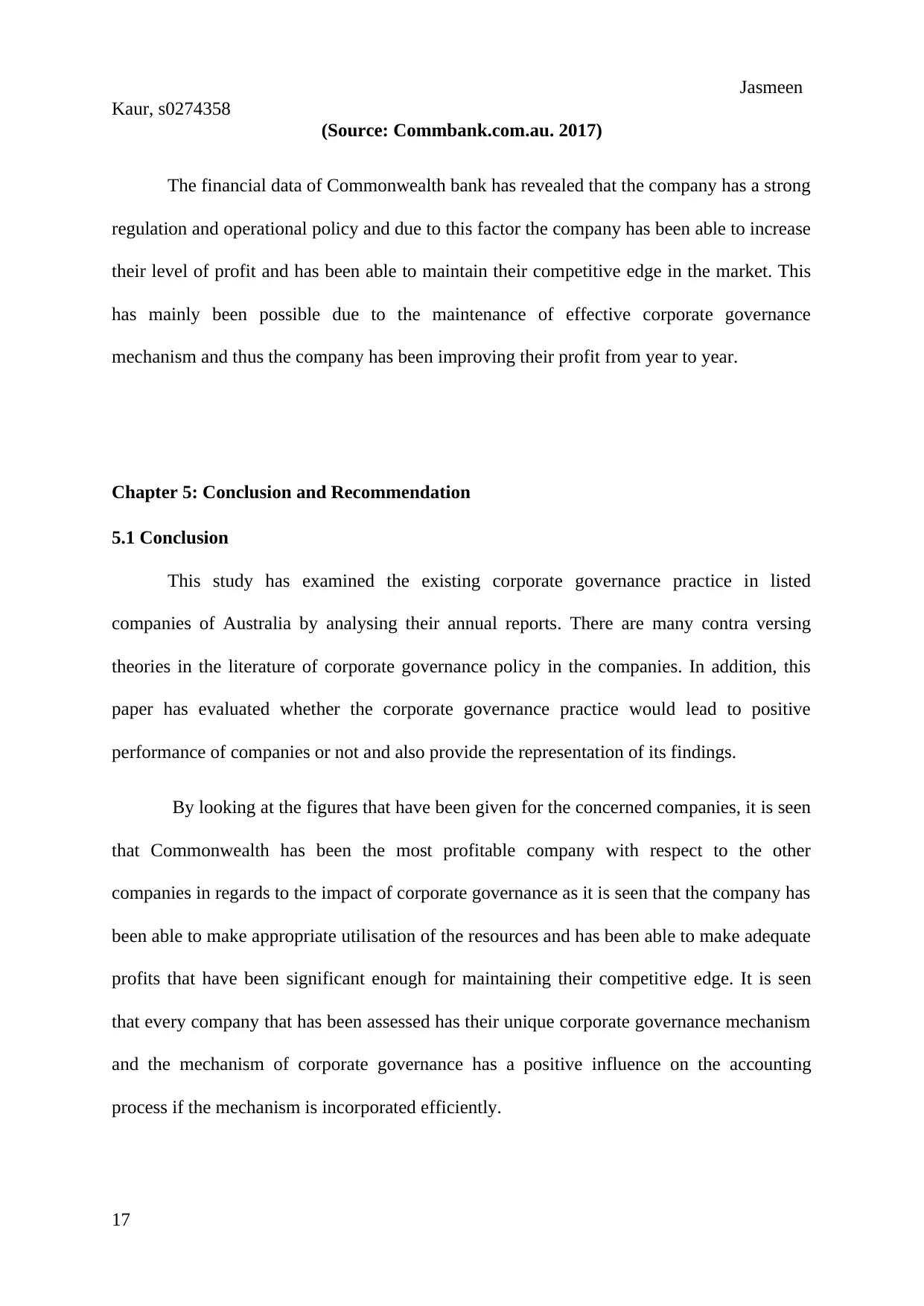
Jasmeen
Kaur, s0274358
(Source: Commbank.com.au. 2017)
The financial data of Commonwealth bank has revealed that the company has a strong
regulation and operational policy and due to this factor the company has been able to increase
their level of profit and has been able to maintain their competitive edge in the market. This
has mainly been possible due to the maintenance of effective corporate governance
mechanism and thus the company has been improving their profit from year to year.
Chapter 5: Conclusion and Recommendation
5.1 Conclusion
This study has examined the existing corporate governance practice in listed
companies of Australia by analysing their annual reports. There are many contra versing
theories in the literature of corporate governance policy in the companies. In addition, this
paper has evaluated whether the corporate governance practice would lead to positive
performance of companies or not and also provide the representation of its findings.
By looking at the figures that have been given for the concerned companies, it is seen
that Commonwealth has been the most profitable company with respect to the other
companies in regards to the impact of corporate governance as it is seen that the company has
been able to make appropriate utilisation of the resources and has been able to make adequate
profits that have been significant enough for maintaining their competitive edge. It is seen
that every company that has been assessed has their unique corporate governance mechanism
and the mechanism of corporate governance has a positive influence on the accounting
process if the mechanism is incorporated efficiently.
17
Kaur, s0274358
(Source: Commbank.com.au. 2017)
The financial data of Commonwealth bank has revealed that the company has a strong
regulation and operational policy and due to this factor the company has been able to increase
their level of profit and has been able to maintain their competitive edge in the market. This
has mainly been possible due to the maintenance of effective corporate governance
mechanism and thus the company has been improving their profit from year to year.
Chapter 5: Conclusion and Recommendation
5.1 Conclusion
This study has examined the existing corporate governance practice in listed
companies of Australia by analysing their annual reports. There are many contra versing
theories in the literature of corporate governance policy in the companies. In addition, this
paper has evaluated whether the corporate governance practice would lead to positive
performance of companies or not and also provide the representation of its findings.
By looking at the figures that have been given for the concerned companies, it is seen
that Commonwealth has been the most profitable company with respect to the other
companies in regards to the impact of corporate governance as it is seen that the company has
been able to make appropriate utilisation of the resources and has been able to make adequate
profits that have been significant enough for maintaining their competitive edge. It is seen
that every company that has been assessed has their unique corporate governance mechanism
and the mechanism of corporate governance has a positive influence on the accounting
process if the mechanism is incorporated efficiently.
17
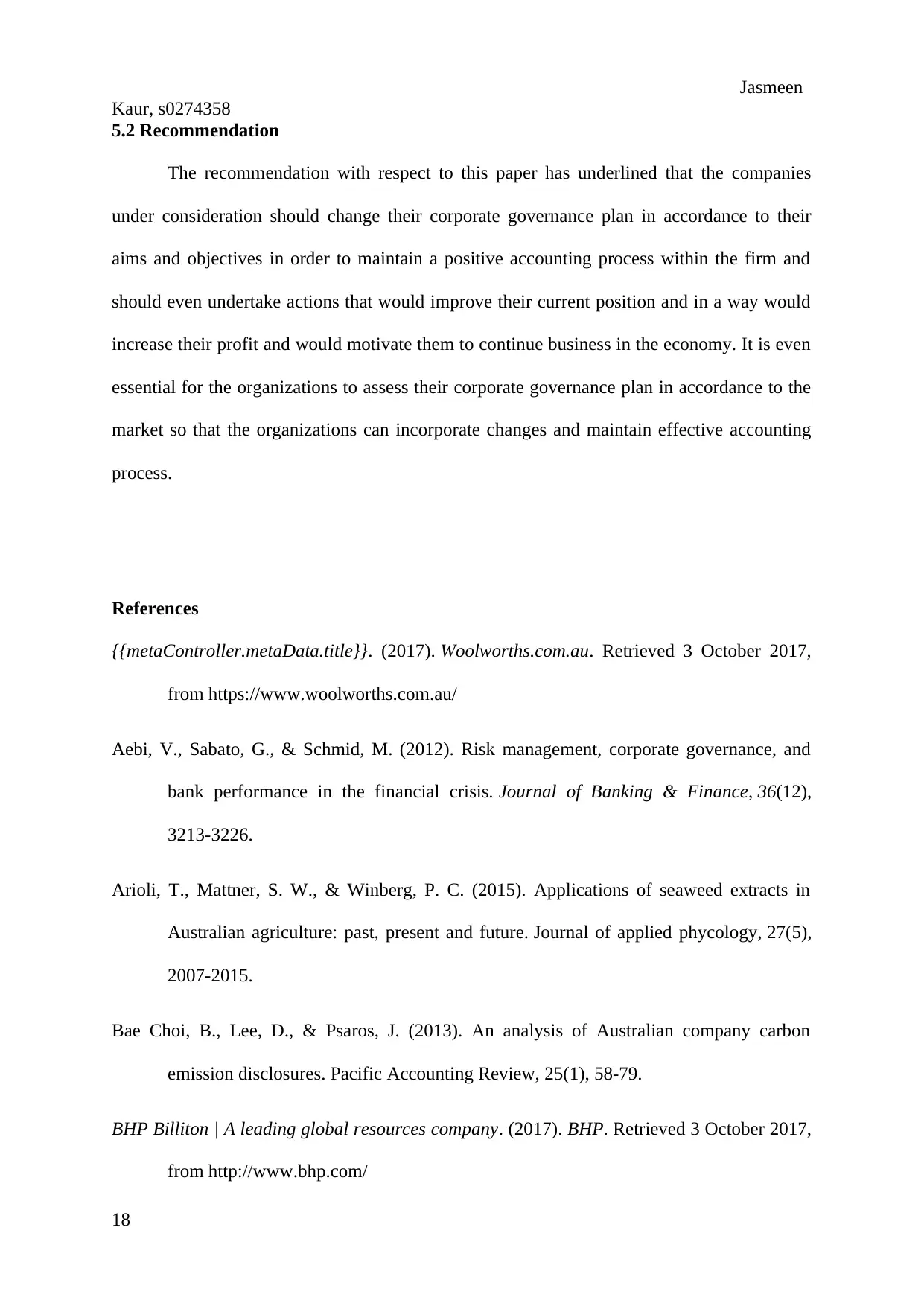
Jasmeen
Kaur, s0274358
5.2 Recommendation
The recommendation with respect to this paper has underlined that the companies
under consideration should change their corporate governance plan in accordance to their
aims and objectives in order to maintain a positive accounting process within the firm and
should even undertake actions that would improve their current position and in a way would
increase their profit and would motivate them to continue business in the economy. It is even
essential for the organizations to assess their corporate governance plan in accordance to the
market so that the organizations can incorporate changes and maintain effective accounting
process.
References
{{metaController.metaData.title}}. (2017). Woolworths.com.au. Retrieved 3 October 2017,
from https://www.woolworths.com.au/
Aebi, V., Sabato, G., & Schmid, M. (2012). Risk management, corporate governance, and
bank performance in the financial crisis. Journal of Banking & Finance, 36(12),
3213-3226.
Arioli, T., Mattner, S. W., & Winberg, P. C. (2015). Applications of seaweed extracts in
Australian agriculture: past, present and future. Journal of applied phycology, 27(5),
2007-2015.
Bae Choi, B., Lee, D., & Psaros, J. (2013). An analysis of Australian company carbon
emission disclosures. Pacific Accounting Review, 25(1), 58-79.
BHP Billiton | A leading global resources company. (2017). BHP. Retrieved 3 October 2017,
from http://www.bhp.com/
18
Kaur, s0274358
5.2 Recommendation
The recommendation with respect to this paper has underlined that the companies
under consideration should change their corporate governance plan in accordance to their
aims and objectives in order to maintain a positive accounting process within the firm and
should even undertake actions that would improve their current position and in a way would
increase their profit and would motivate them to continue business in the economy. It is even
essential for the organizations to assess their corporate governance plan in accordance to the
market so that the organizations can incorporate changes and maintain effective accounting
process.
References
{{metaController.metaData.title}}. (2017). Woolworths.com.au. Retrieved 3 October 2017,
from https://www.woolworths.com.au/
Aebi, V., Sabato, G., & Schmid, M. (2012). Risk management, corporate governance, and
bank performance in the financial crisis. Journal of Banking & Finance, 36(12),
3213-3226.
Arioli, T., Mattner, S. W., & Winberg, P. C. (2015). Applications of seaweed extracts in
Australian agriculture: past, present and future. Journal of applied phycology, 27(5),
2007-2015.
Bae Choi, B., Lee, D., & Psaros, J. (2013). An analysis of Australian company carbon
emission disclosures. Pacific Accounting Review, 25(1), 58-79.
BHP Billiton | A leading global resources company. (2017). BHP. Retrieved 3 October 2017,
from http://www.bhp.com/
18
You're viewing a preview
Unlock full access by subscribing today!

Jasmeen
Kaur, s0274358
Butlin, N. G. (2013). Investment in Australian economic development, 1861-1900.
Cambridge University Press.
Cheng, B., Ioannou, I., & Serafeim, G. (2014). Corporate social responsibility and access to
finance. Strategic Management Journal, 35(1), 1-23.
Collett, P., & Hrasky, S. (2005). Voluntary disclosure of corporate governance practices by
listed Australian companies. Corporate Governance: An International Review, 13(2),
188-196
Dallas, L. (2012). Short-termism, the financial crisis, and corporate governance.
Eccles, R. G., Ioannou, I., & Serafeim, G. (2014). The impact of corporate sustainability on
organizational processes and performance. Management Science, 60(11), 2835-2857.
Erkens, D. H., Hung, M., & Matos, P. (2012). Corporate governance in the 2007–2008
financial crisis: Evidence from financial institutions worldwide. Journal of Corporate
Finance, 18(2), 389-411.
Erkens, D. H., Hung, M., & Matos, P. (2012). Corporate governance in the 2007–2008
financial crisis: Evidence from financial institutions worldwide. Journal of Corporate
Finance, 18(2), 389-411.
Haug, A. S. (2017). Growth Strategies in the Australian Health and Fitness Industry:
Franchised vs Company-Owned Outlets(Doctoral dissertation, Victoria University).
Hermalin, B. E., & Weisbach, M. S. (2012). Information disclosure and corporate
governance. The Journal of Finance, 67(1), 195-233.
Home. (2017). Wesfarmers.com.au. Retrieved 3 October 2017, from
http://www.wesfarmers.com.au/
19
Kaur, s0274358
Butlin, N. G. (2013). Investment in Australian economic development, 1861-1900.
Cambridge University Press.
Cheng, B., Ioannou, I., & Serafeim, G. (2014). Corporate social responsibility and access to
finance. Strategic Management Journal, 35(1), 1-23.
Collett, P., & Hrasky, S. (2005). Voluntary disclosure of corporate governance practices by
listed Australian companies. Corporate Governance: An International Review, 13(2),
188-196
Dallas, L. (2012). Short-termism, the financial crisis, and corporate governance.
Eccles, R. G., Ioannou, I., & Serafeim, G. (2014). The impact of corporate sustainability on
organizational processes and performance. Management Science, 60(11), 2835-2857.
Erkens, D. H., Hung, M., & Matos, P. (2012). Corporate governance in the 2007–2008
financial crisis: Evidence from financial institutions worldwide. Journal of Corporate
Finance, 18(2), 389-411.
Erkens, D. H., Hung, M., & Matos, P. (2012). Corporate governance in the 2007–2008
financial crisis: Evidence from financial institutions worldwide. Journal of Corporate
Finance, 18(2), 389-411.
Haug, A. S. (2017). Growth Strategies in the Australian Health and Fitness Industry:
Franchised vs Company-Owned Outlets(Doctoral dissertation, Victoria University).
Hermalin, B. E., & Weisbach, M. S. (2012). Information disclosure and corporate
governance. The Journal of Finance, 67(1), 195-233.
Home. (2017). Wesfarmers.com.au. Retrieved 3 October 2017, from
http://www.wesfarmers.com.au/
19
Paraphrase This Document
Need a fresh take? Get an instant paraphrase of this document with our AI Paraphraser
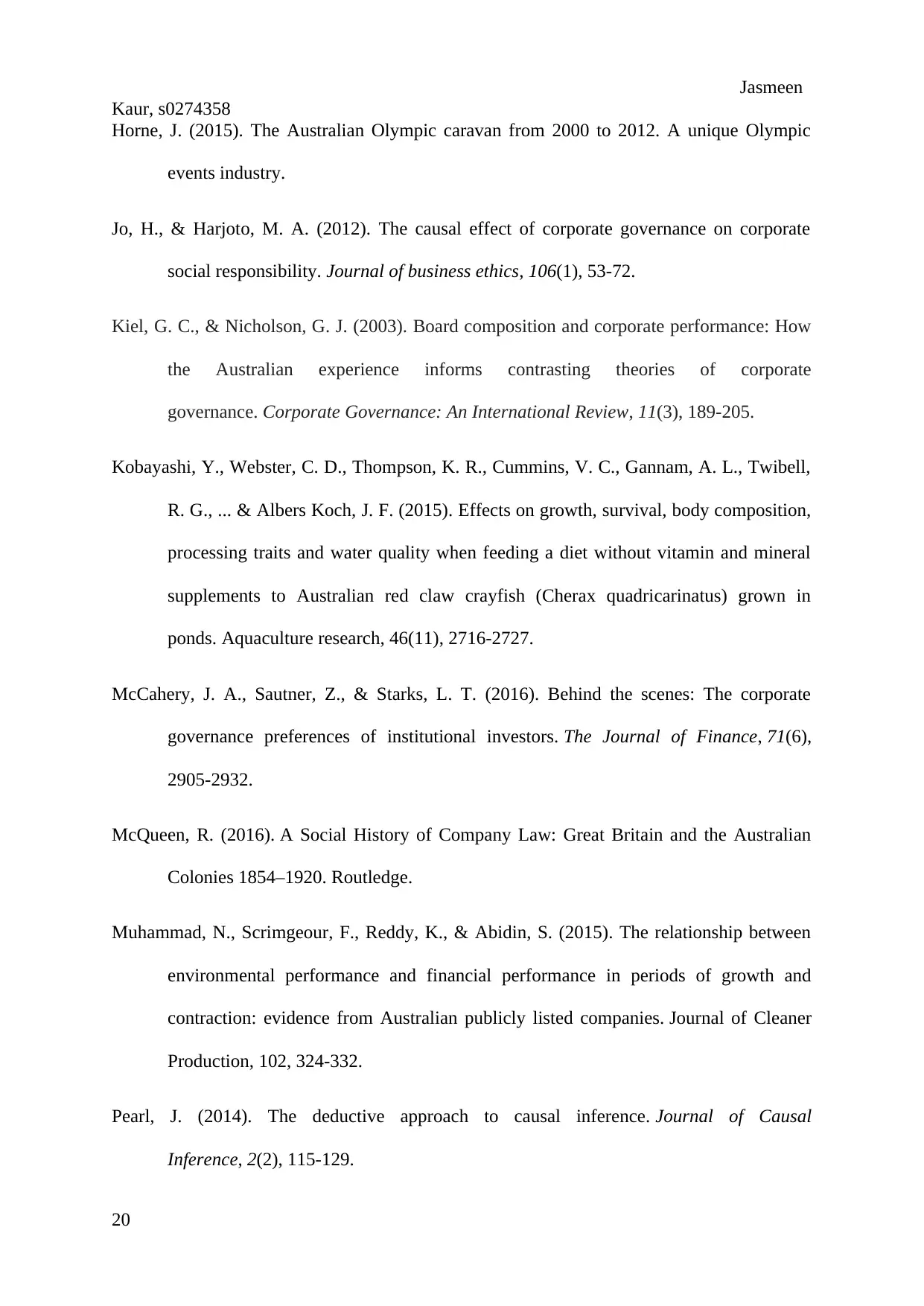
Jasmeen
Kaur, s0274358
Horne, J. (2015). The Australian Olympic caravan from 2000 to 2012. A unique Olympic
events industry.
Jo, H., & Harjoto, M. A. (2012). The causal effect of corporate governance on corporate
social responsibility. Journal of business ethics, 106(1), 53-72.
Kiel, G. C., & Nicholson, G. J. (2003). Board composition and corporate performance: How
the Australian experience informs contrasting theories of corporate
governance. Corporate Governance: An International Review, 11(3), 189-205.
Kobayashi, Y., Webster, C. D., Thompson, K. R., Cummins, V. C., Gannam, A. L., Twibell,
R. G., ... & Albers Koch, J. F. (2015). Effects on growth, survival, body composition,
processing traits and water quality when feeding a diet without vitamin and mineral
supplements to Australian red claw crayfish (Cherax quadricarinatus) grown in
ponds. Aquaculture research, 46(11), 2716-2727.
McCahery, J. A., Sautner, Z., & Starks, L. T. (2016). Behind the scenes: The corporate
governance preferences of institutional investors. The Journal of Finance, 71(6),
2905-2932.
McQueen, R. (2016). A Social History of Company Law: Great Britain and the Australian
Colonies 1854–1920. Routledge.
Muhammad, N., Scrimgeour, F., Reddy, K., & Abidin, S. (2015). The relationship between
environmental performance and financial performance in periods of growth and
contraction: evidence from Australian publicly listed companies. Journal of Cleaner
Production, 102, 324-332.
Pearl, J. (2014). The deductive approach to causal inference. Journal of Causal
Inference, 2(2), 115-129.
20
Kaur, s0274358
Horne, J. (2015). The Australian Olympic caravan from 2000 to 2012. A unique Olympic
events industry.
Jo, H., & Harjoto, M. A. (2012). The causal effect of corporate governance on corporate
social responsibility. Journal of business ethics, 106(1), 53-72.
Kiel, G. C., & Nicholson, G. J. (2003). Board composition and corporate performance: How
the Australian experience informs contrasting theories of corporate
governance. Corporate Governance: An International Review, 11(3), 189-205.
Kobayashi, Y., Webster, C. D., Thompson, K. R., Cummins, V. C., Gannam, A. L., Twibell,
R. G., ... & Albers Koch, J. F. (2015). Effects on growth, survival, body composition,
processing traits and water quality when feeding a diet without vitamin and mineral
supplements to Australian red claw crayfish (Cherax quadricarinatus) grown in
ponds. Aquaculture research, 46(11), 2716-2727.
McCahery, J. A., Sautner, Z., & Starks, L. T. (2016). Behind the scenes: The corporate
governance preferences of institutional investors. The Journal of Finance, 71(6),
2905-2932.
McQueen, R. (2016). A Social History of Company Law: Great Britain and the Australian
Colonies 1854–1920. Routledge.
Muhammad, N., Scrimgeour, F., Reddy, K., & Abidin, S. (2015). The relationship between
environmental performance and financial performance in periods of growth and
contraction: evidence from Australian publicly listed companies. Journal of Cleaner
Production, 102, 324-332.
Pearl, J. (2014). The deductive approach to causal inference. Journal of Causal
Inference, 2(2), 115-129.
20
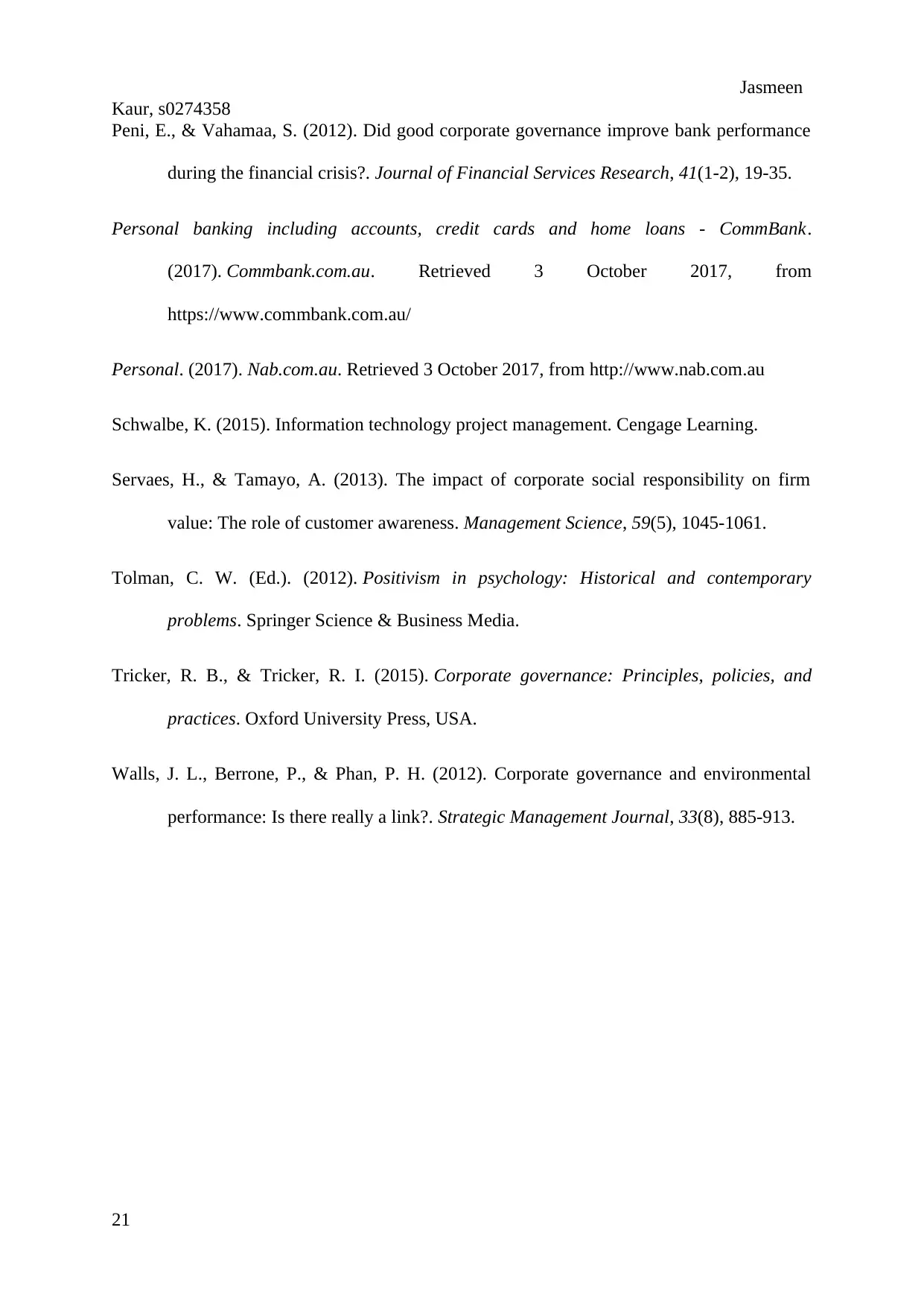
Jasmeen
Kaur, s0274358
Peni, E., & Vahamaa, S. (2012). Did good corporate governance improve bank performance
during the financial crisis?. Journal of Financial Services Research, 41(1-2), 19-35.
Personal banking including accounts, credit cards and home loans - CommBank.
(2017). Commbank.com.au. Retrieved 3 October 2017, from
https://www.commbank.com.au/
Personal. (2017). Nab.com.au. Retrieved 3 October 2017, from http://www.nab.com.au
Schwalbe, K. (2015). Information technology project management. Cengage Learning.
Servaes, H., & Tamayo, A. (2013). The impact of corporate social responsibility on firm
value: The role of customer awareness. Management Science, 59(5), 1045-1061.
Tolman, C. W. (Ed.). (2012). Positivism in psychology: Historical and contemporary
problems. Springer Science & Business Media.
Tricker, R. B., & Tricker, R. I. (2015). Corporate governance: Principles, policies, and
practices. Oxford University Press, USA.
Walls, J. L., Berrone, P., & Phan, P. H. (2012). Corporate governance and environmental
performance: Is there really a link?. Strategic Management Journal, 33(8), 885-913.
21
Kaur, s0274358
Peni, E., & Vahamaa, S. (2012). Did good corporate governance improve bank performance
during the financial crisis?. Journal of Financial Services Research, 41(1-2), 19-35.
Personal banking including accounts, credit cards and home loans - CommBank.
(2017). Commbank.com.au. Retrieved 3 October 2017, from
https://www.commbank.com.au/
Personal. (2017). Nab.com.au. Retrieved 3 October 2017, from http://www.nab.com.au
Schwalbe, K. (2015). Information technology project management. Cengage Learning.
Servaes, H., & Tamayo, A. (2013). The impact of corporate social responsibility on firm
value: The role of customer awareness. Management Science, 59(5), 1045-1061.
Tolman, C. W. (Ed.). (2012). Positivism in psychology: Historical and contemporary
problems. Springer Science & Business Media.
Tricker, R. B., & Tricker, R. I. (2015). Corporate governance: Principles, policies, and
practices. Oxford University Press, USA.
Walls, J. L., Berrone, P., & Phan, P. H. (2012). Corporate governance and environmental
performance: Is there really a link?. Strategic Management Journal, 33(8), 885-913.
21
You're viewing a preview
Unlock full access by subscribing today!
1 out of 21
Related Documents
Your All-in-One AI-Powered Toolkit for Academic Success.
+13062052269
info@desklib.com
Available 24*7 on WhatsApp / Email
![[object Object]](/_next/static/media/star-bottom.7253800d.svg)
Unlock your academic potential
© 2024 | Zucol Services PVT LTD | All rights reserved.





